My most current blog entry:
Entries in Food (26)
Winter Vacation 2013/14, Part One: Stuttgart
 Saturday, January 4, 2014 at 10:22PM
Saturday, January 4, 2014 at 10:22PM Our Winter vacation started off with a flight from Aberdeen, Scotland to Copenhagen, Denmark where we caught a connection to Geneva, Switzerland. My CRS flared up and and I left behind my camera bag at the security check-in at the Aberdeen Airport. A phone call to Aberdeen fortunately yielded the good news that my expensive camera equipment was safely locked up in their lost and found. Whew!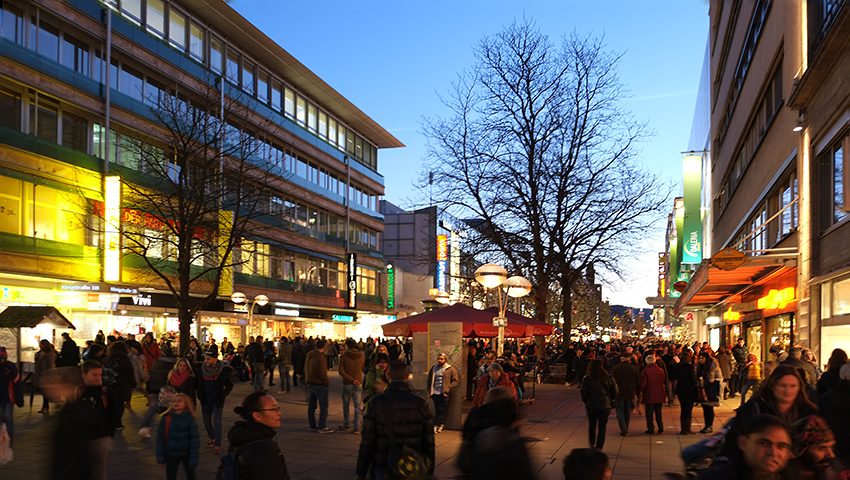 We stayed the night with good freinds on their lovely farm outside Geneva and then headed off to the medeival German town of Rothenburg ob der Tauber. In route, I picked up the excellent Fuji X-E1 camera fitted to their equally excellent IS 18-55mm zoom lens at the Geneva Duty Free. I couldn't go on this vacation without taking some photos! We arrived in Stuttgart for a one night layover before our train to Rothenburg ob der Tauber. As it turned out, the Stuttgart Christmas Market (first started in 1692) was in it's last night!
We stayed the night with good freinds on their lovely farm outside Geneva and then headed off to the medeival German town of Rothenburg ob der Tauber. In route, I picked up the excellent Fuji X-E1 camera fitted to their equally excellent IS 18-55mm zoom lens at the Geneva Duty Free. I couldn't go on this vacation without taking some photos! We arrived in Stuttgart for a one night layover before our train to Rothenburg ob der Tauber. As it turned out, the Stuttgart Christmas Market (first started in 1692) was in it's last night!
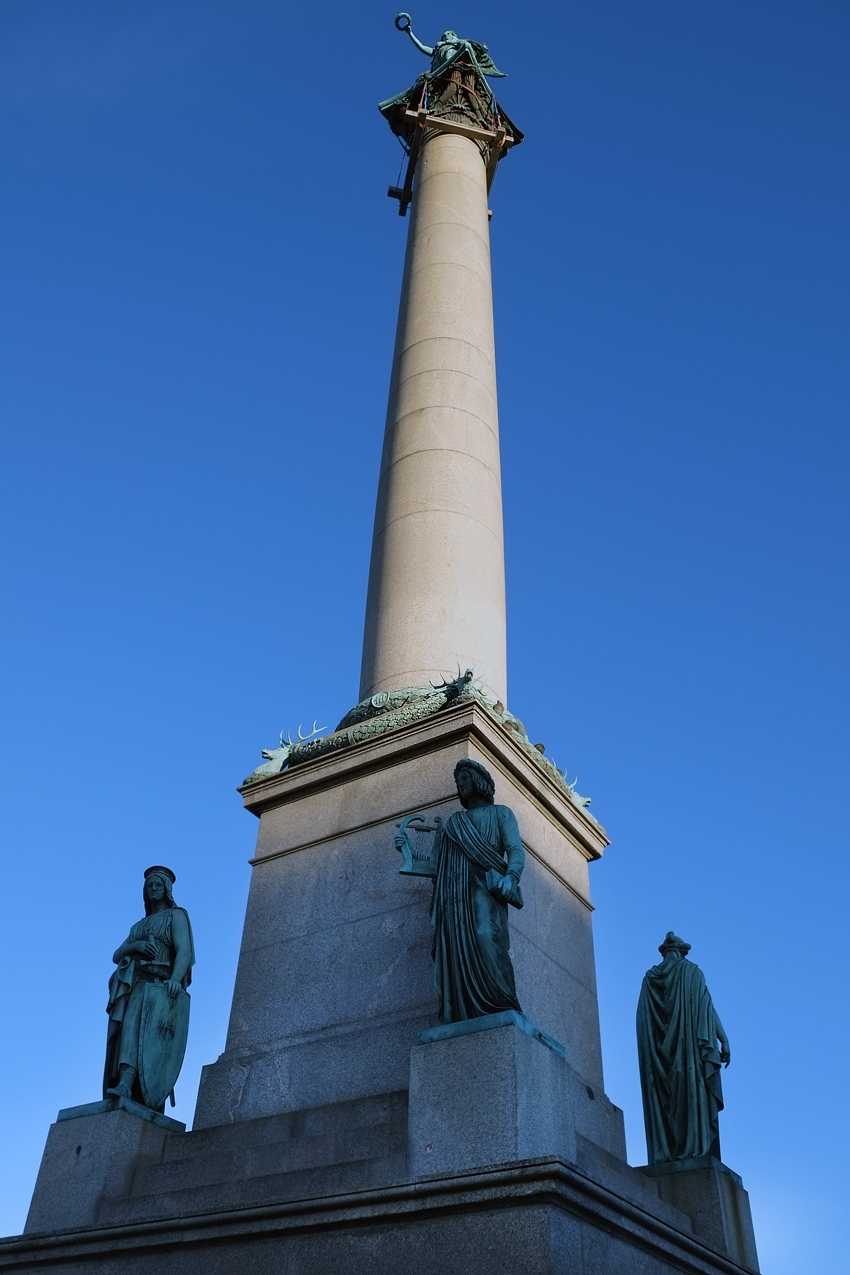 A monument as only the Germans can make them. Heroic, gigantic, romantic.
A monument as only the Germans can make them. Heroic, gigantic, romantic.
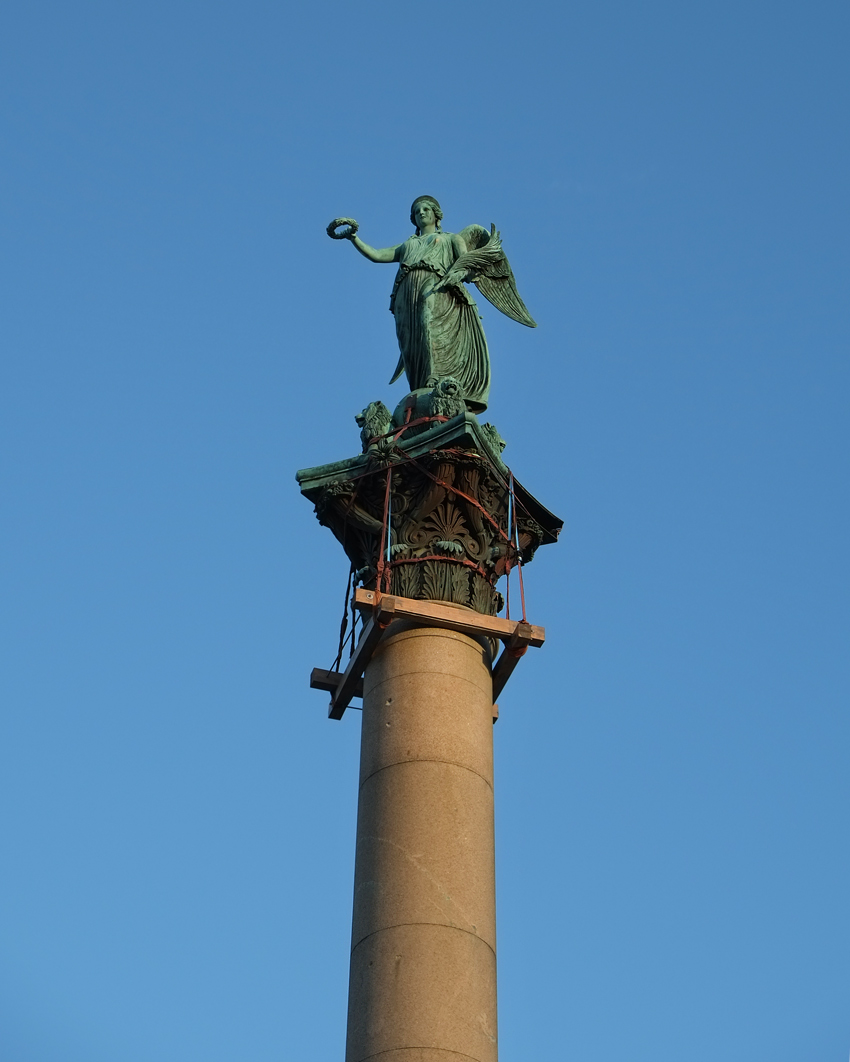 Stuttgart Winged Liberty (under repair).
Stuttgart Winged Liberty (under repair).
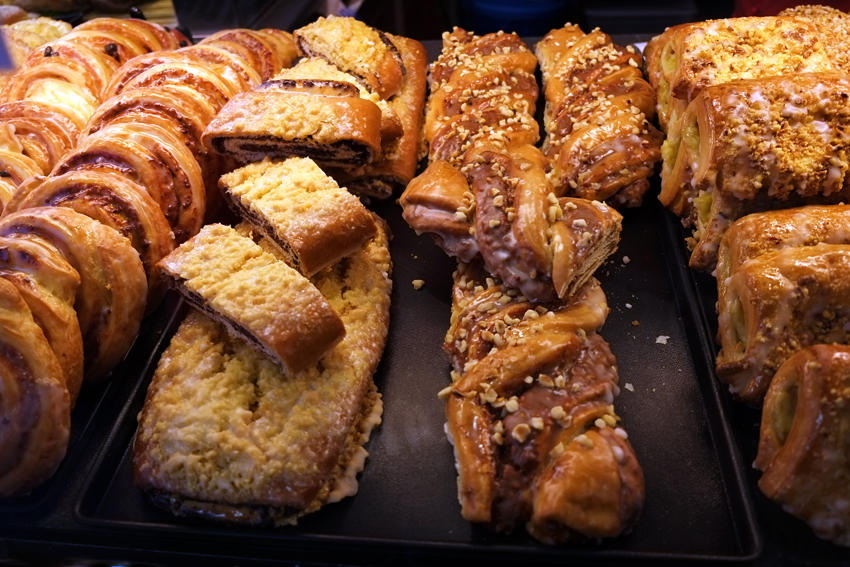 Did I mention Stuttgart pastry . . . it would be worth moving here just for the pastry . . . . almost.
Did I mention Stuttgart pastry . . . it would be worth moving here just for the pastry . . . . almost.
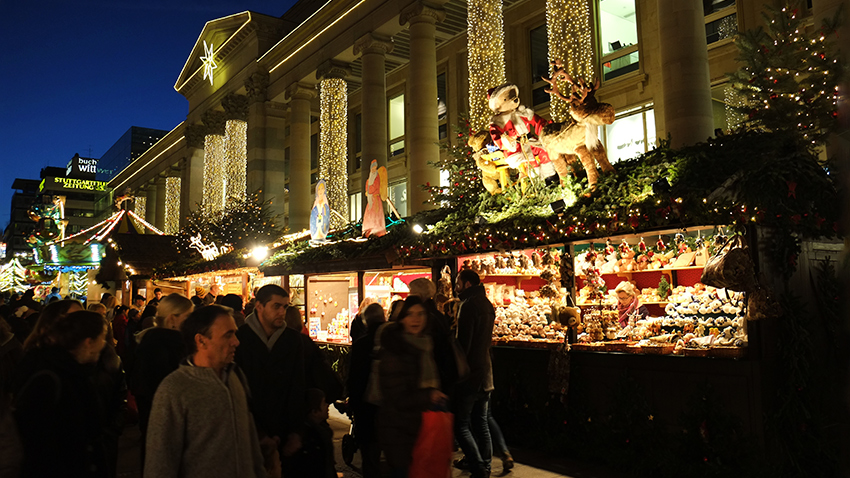 The Christmas Market spread along the entire length of Stuttgart's main walking street.
The Christmas Market spread along the entire length of Stuttgart's main walking street.
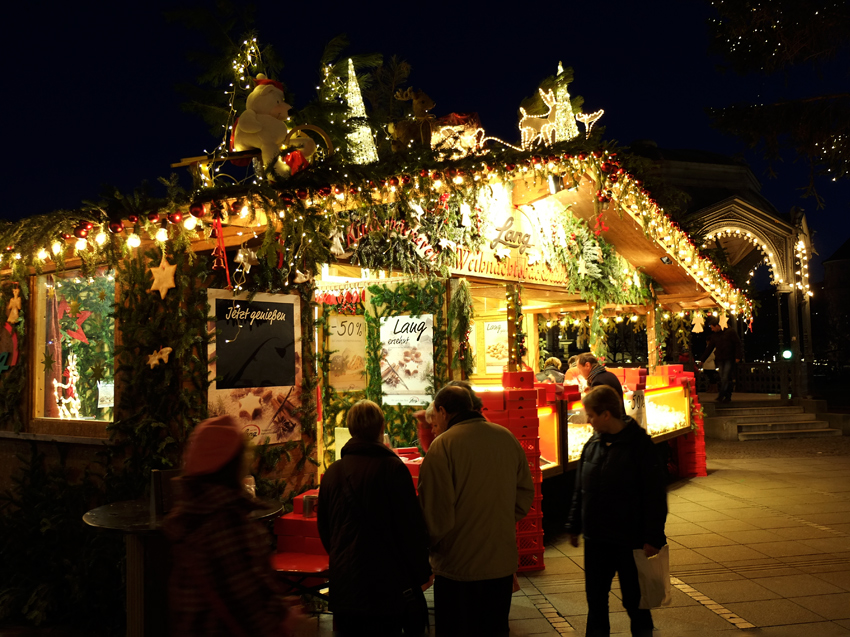 Their were lots of pretty booths set up selling just about everything Christmas-related.
Their were lots of pretty booths set up selling just about everything Christmas-related.
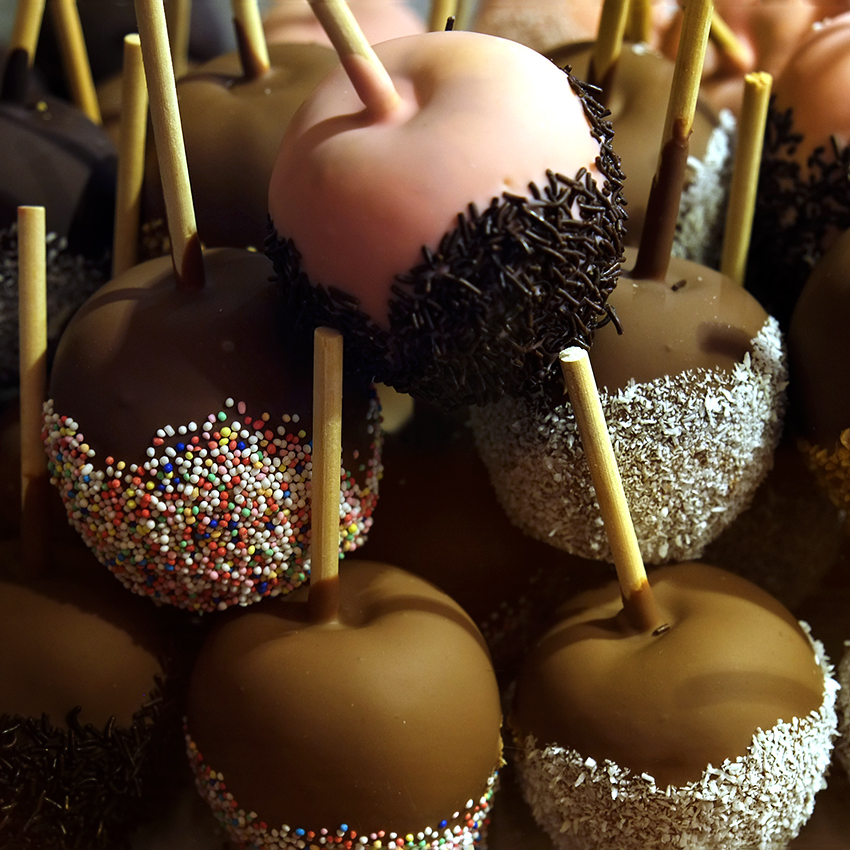 There was a lot of festive seasonal food for sale too.
There was a lot of festive seasonal food for sale too.
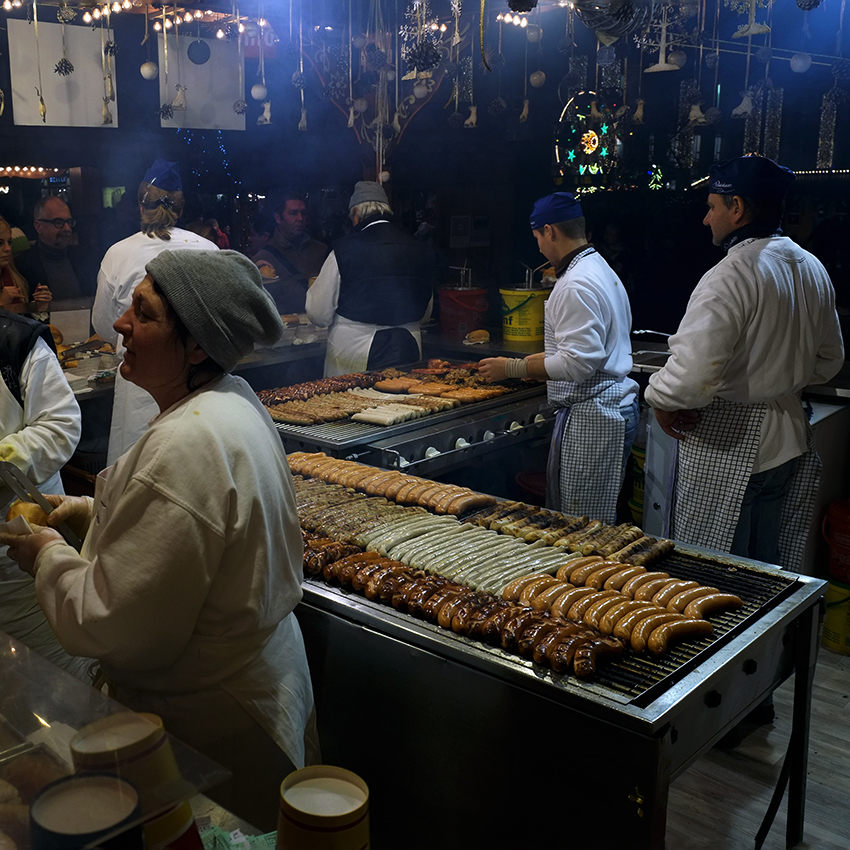 We stopped for delicious sausages and Glühwein (roughly translated, "glow-wine").
We stopped for delicious sausages and Glühwein (roughly translated, "glow-wine").
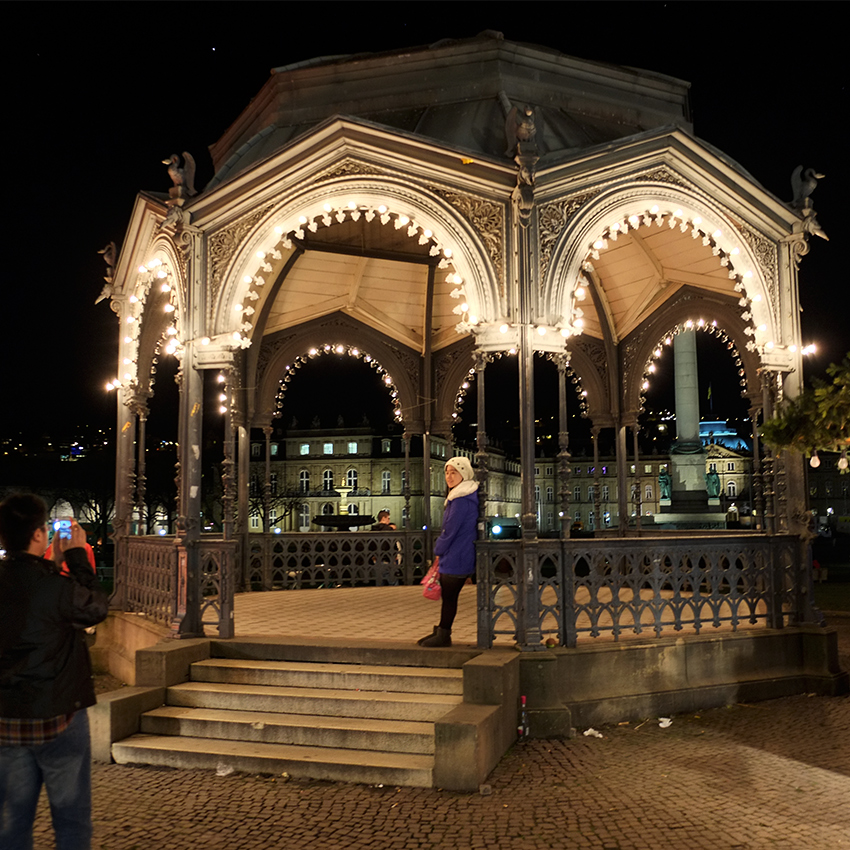 It was a beautiful, not-too-cold night in Stuttgart. There were many tourists in the crowd that night (all, eventually, heading to Rothenburg the next day, we found out).
It was a beautiful, not-too-cold night in Stuttgart. There were many tourists in the crowd that night (all, eventually, heading to Rothenburg the next day, we found out).
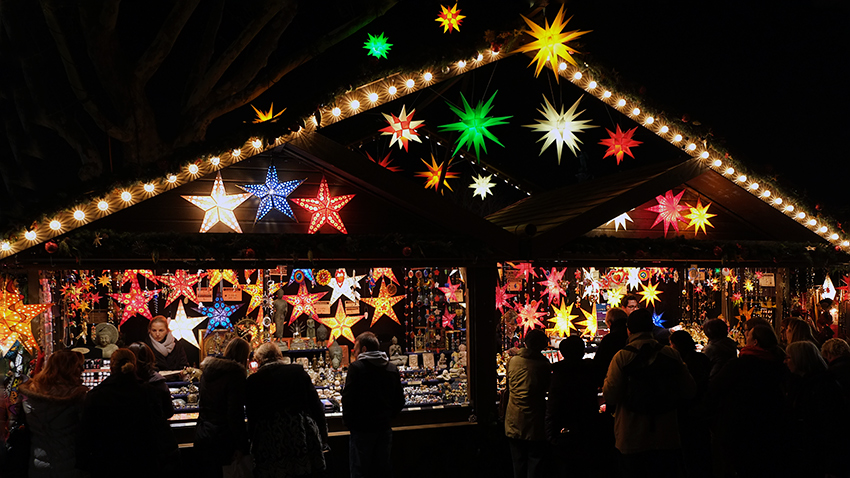 It was a wonderful evening to stroll around with the entire population of Stuttgart looking at the fun and interesting booths.
It was a wonderful evening to stroll around with the entire population of Stuttgart looking at the fun and interesting booths.
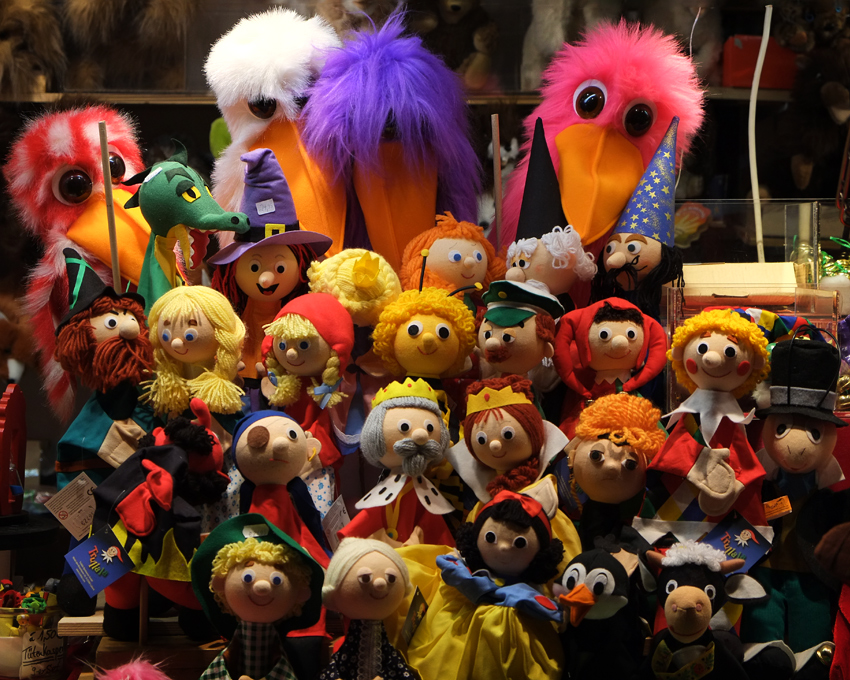 We were tempted . . . . but where would we put it?
We were tempted . . . . but where would we put it?
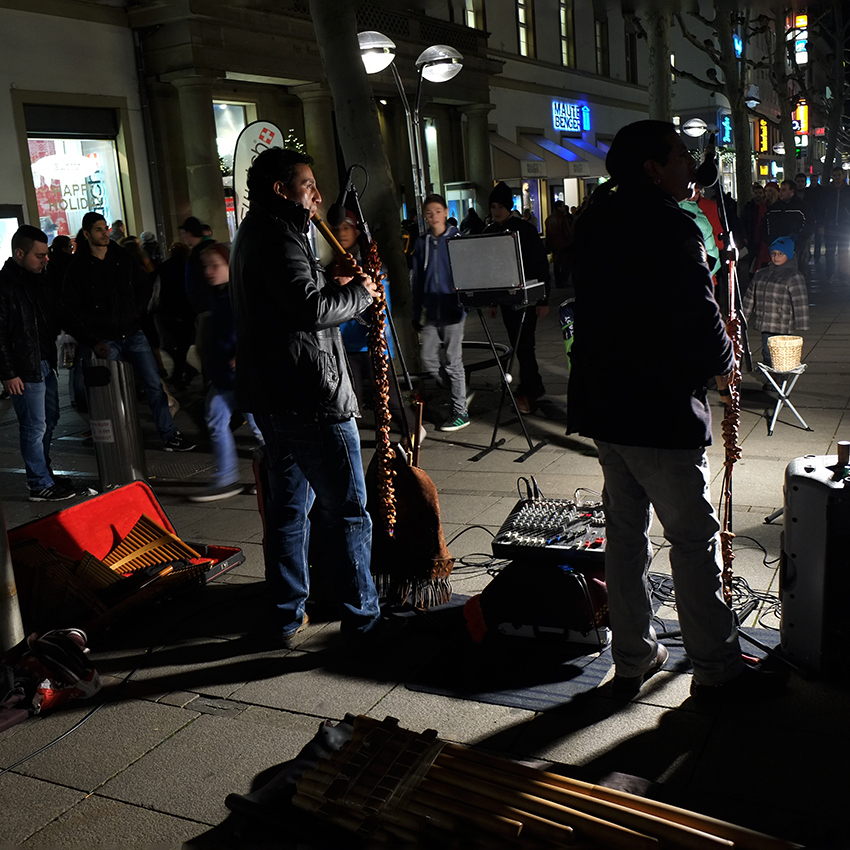 There have been Bolivian street musicians in EVERY European city I have visited in the last twenty years: Stuttgart was no exception! These guys were playing a kind of Bolivian Space Music. Very esoteric.
There have been Bolivian street musicians in EVERY European city I have visited in the last twenty years: Stuttgart was no exception! These guys were playing a kind of Bolivian Space Music. Very esoteric.
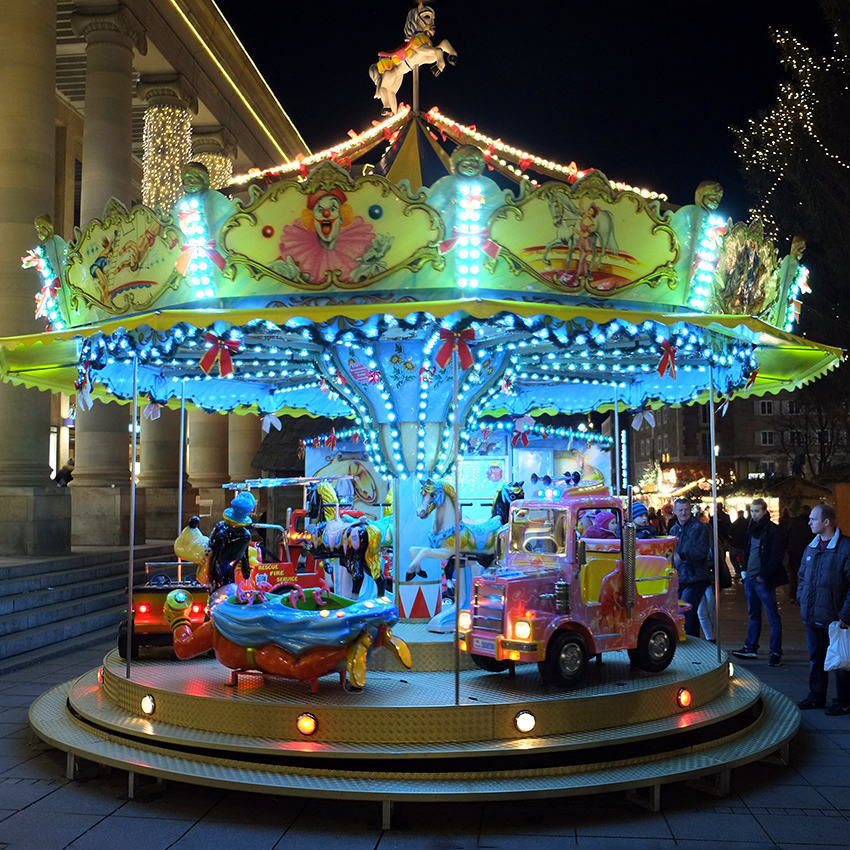 A brightly lit merry-go-round tested the dynamic range capabilities of the new Fuji X-E1 camera. Excellent!
A brightly lit merry-go-round tested the dynamic range capabilities of the new Fuji X-E1 camera. Excellent!
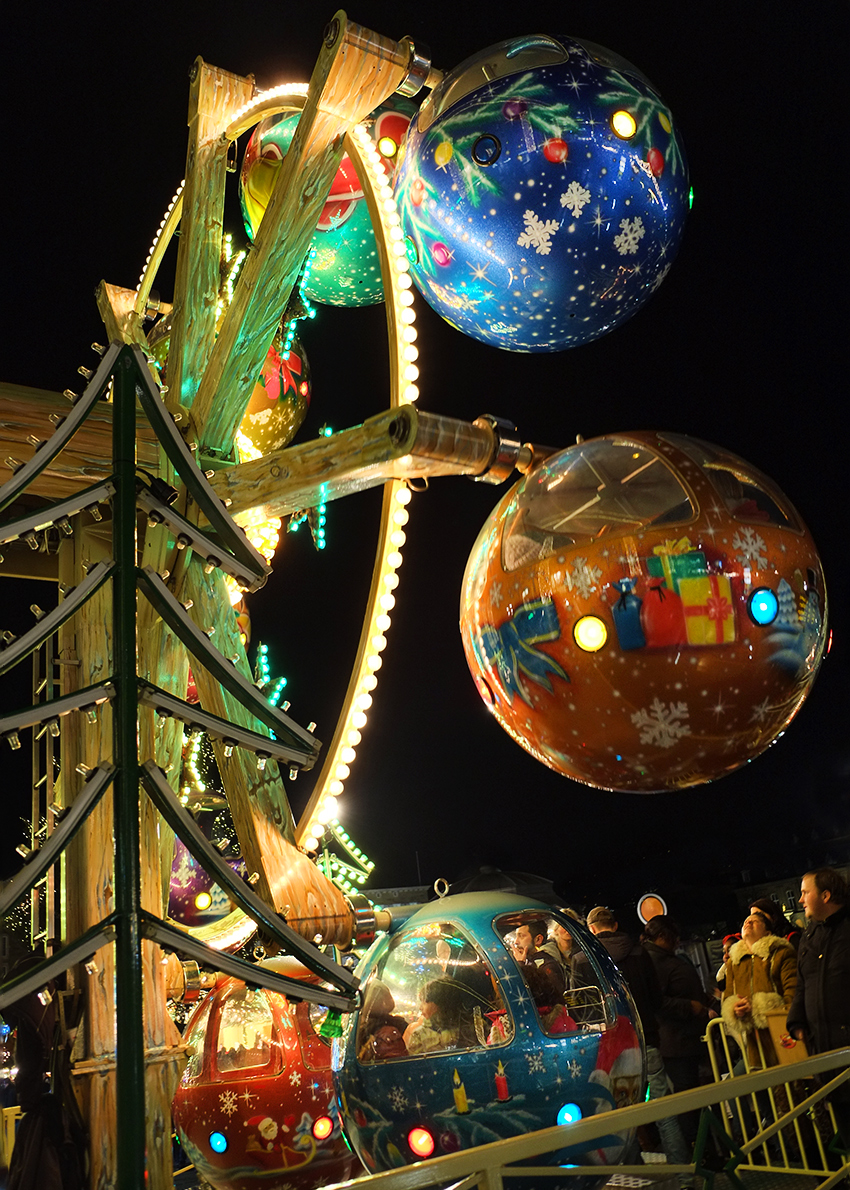 Did they only use this Christmas Tree Bulb Ferris Wheel one month of the year? Who knows . . . it was beautiful!
Did they only use this Christmas Tree Bulb Ferris Wheel one month of the year? Who knows . . . it was beautiful!
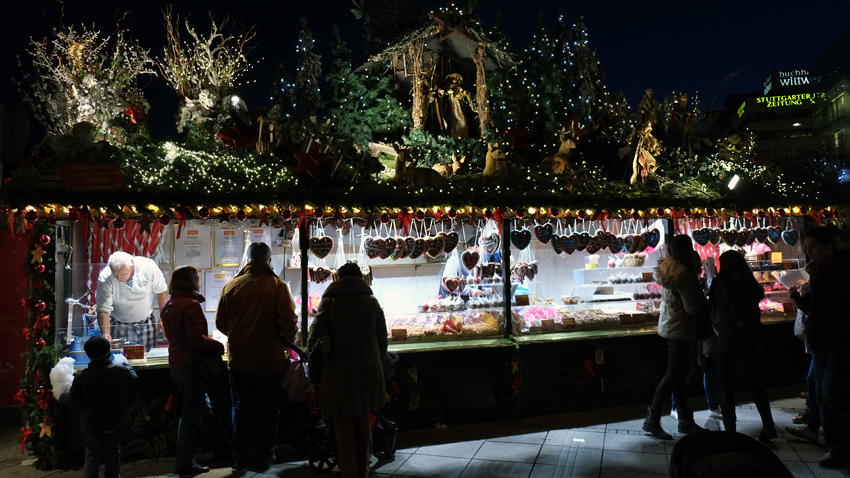 I imagine that the shapes and sizes of these Christmas Gingerbread Hearts have huge significance to the residents of Stuttgart.
I imagine that the shapes and sizes of these Christmas Gingerbread Hearts have huge significance to the residents of Stuttgart.
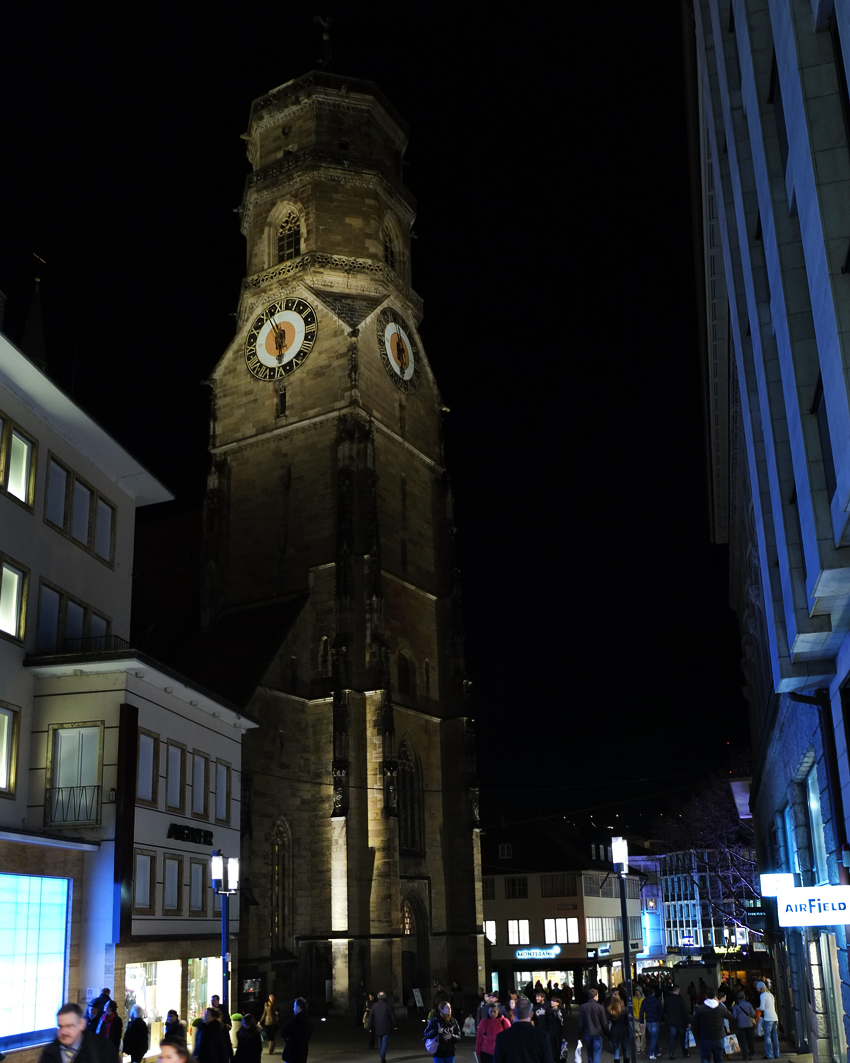 About half way down the walking street my wife made the observation that all the buildings seemed new. Yes, they were . . . because most of Stuttgart was bombed into smithereens in WWII. Only a few old buildings remained, like this cathedral tower.
About half way down the walking street my wife made the observation that all the buildings seemed new. Yes, they were . . . because most of Stuttgart was bombed into smithereens in WWII. Only a few old buildings remained, like this cathedral tower.
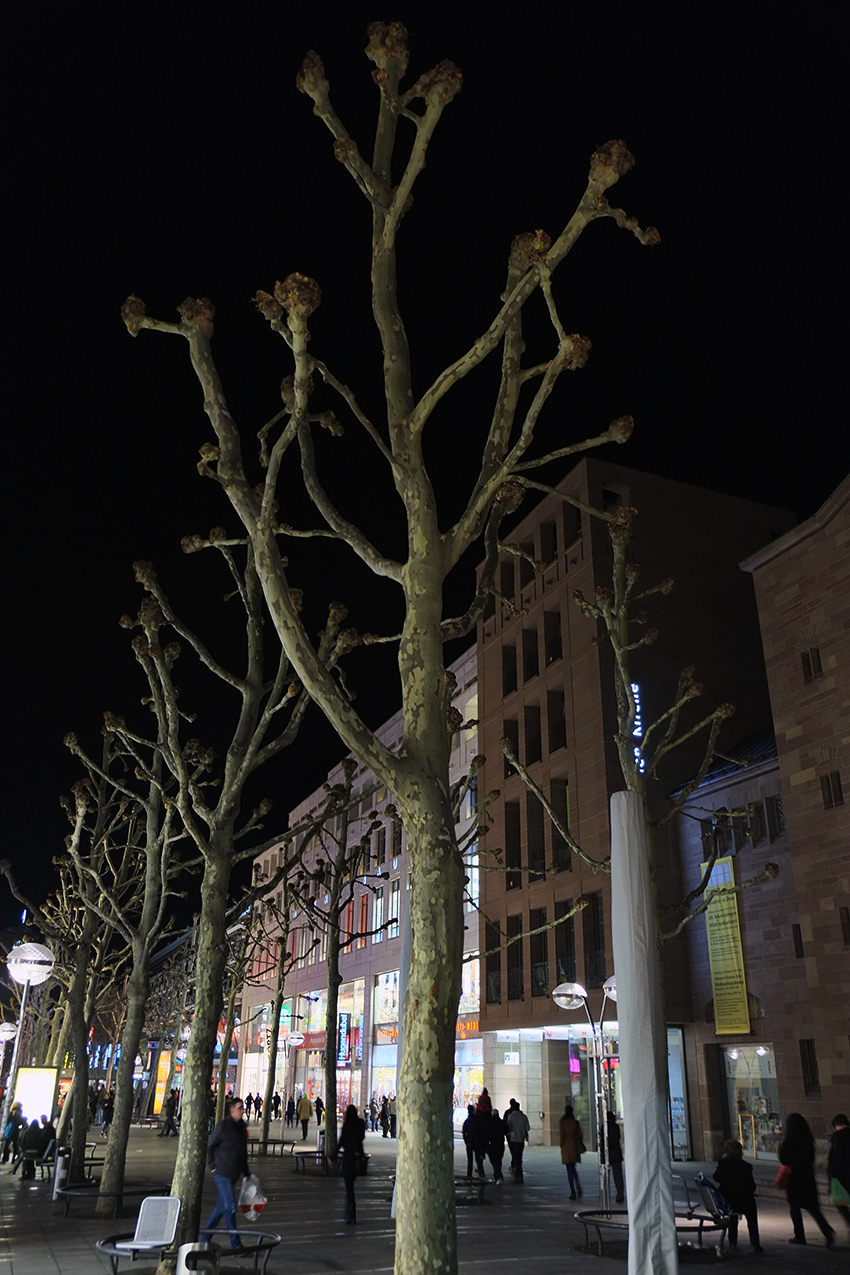 But the Stuttgart city fathers made the most of their suddenly new city by planting and trimming very lovely trees down the promenade.
But the Stuttgart city fathers made the most of their suddenly new city by planting and trimming very lovely trees down the promenade.
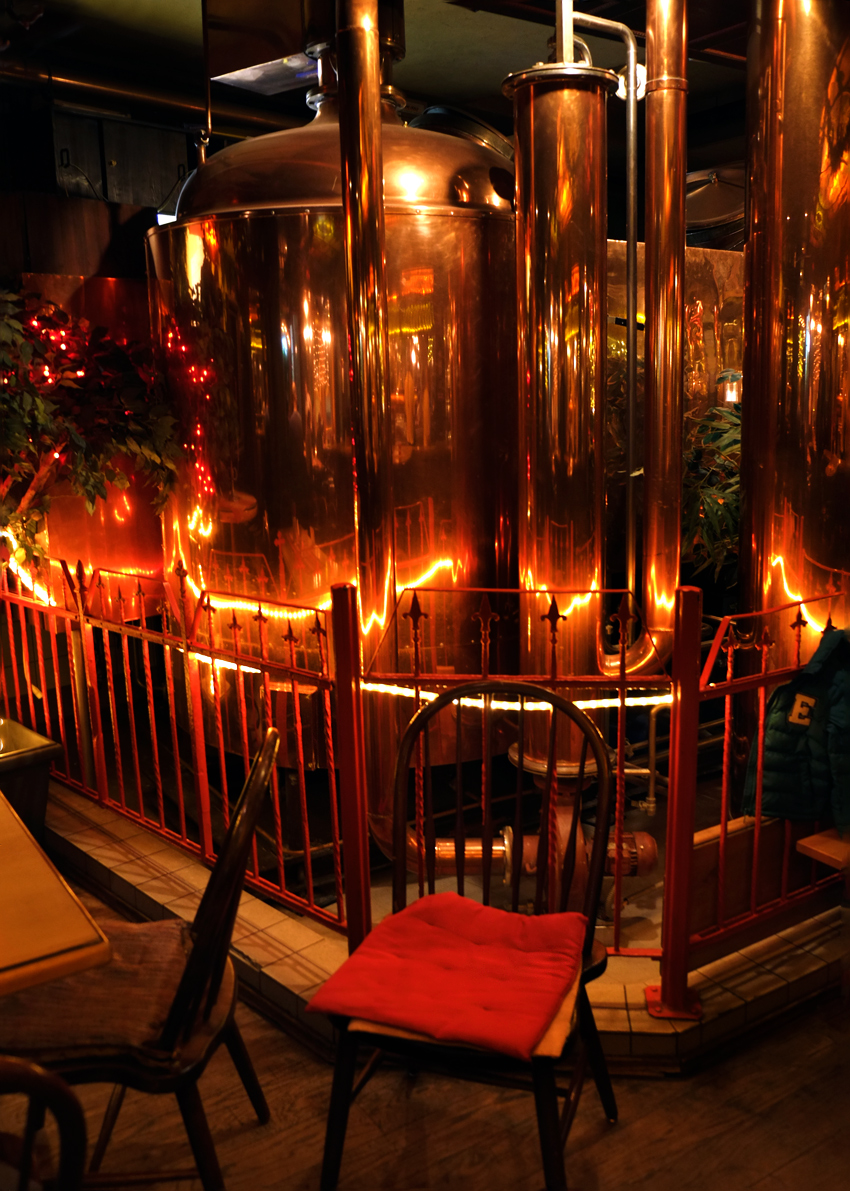 We found a nice beer garden that brewed their own ale, and had delicious pork schnitzel (me) and pork knuckle (my wife) with authentic sauerkraut.
We found a nice beer garden that brewed their own ale, and had delicious pork schnitzel (me) and pork knuckle (my wife) with authentic sauerkraut.
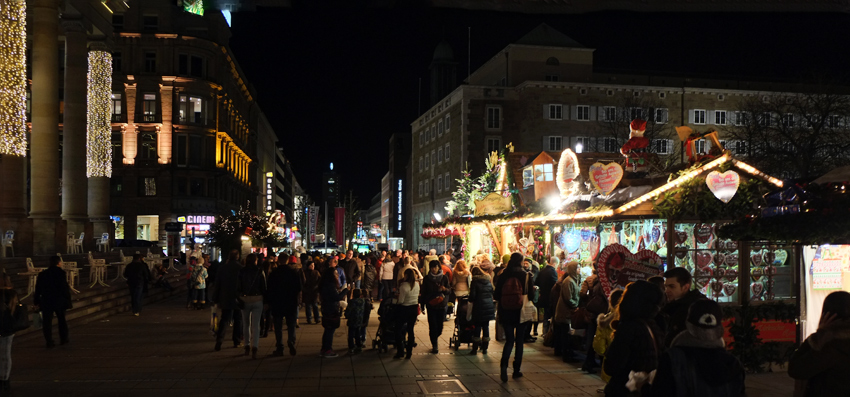 We had a wonderful evening among the throngs before walking back to our hotel.
We had a wonderful evening among the throngs before walking back to our hotel.
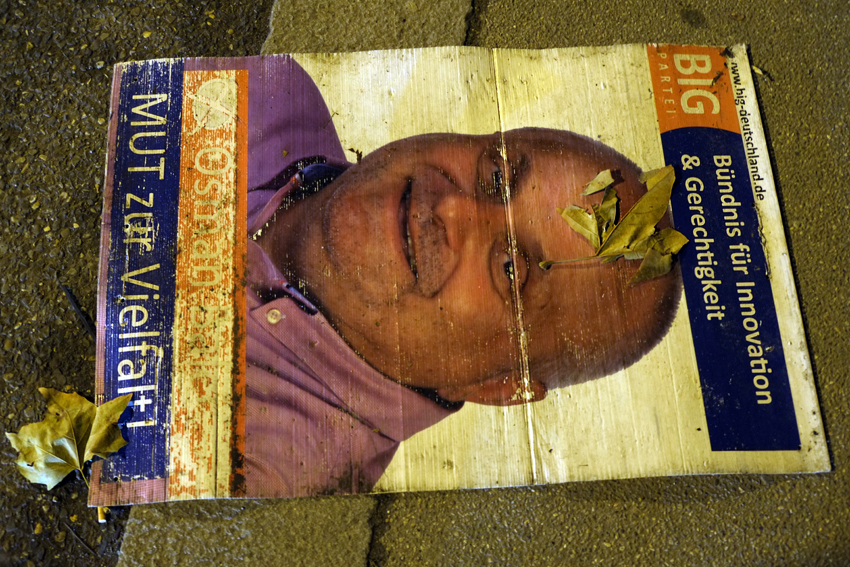 I saw this interesting poster in the gutter on our walk home. I'm guessing it is either a political poster for a politician running in the Big Partei, or it is an invitation to a Big Party. The arrangement of leaves is attractive.
I saw this interesting poster in the gutter on our walk home. I'm guessing it is either a political poster for a politician running in the Big Partei, or it is an invitation to a Big Party. The arrangement of leaves is attractive.
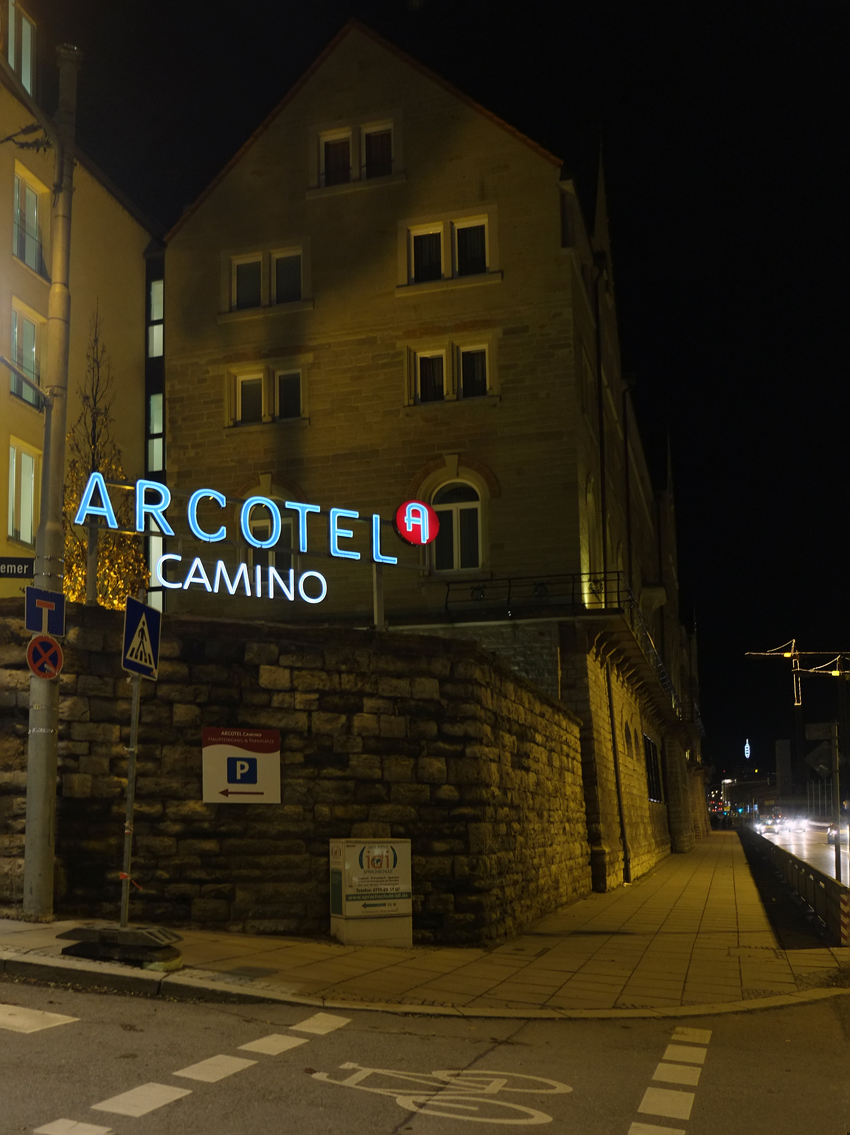 Our hotel was clean and centrally located. We slept well after our long walk in the Christmas Market.
Our hotel was clean and centrally located. We slept well after our long walk in the Christmas Market.
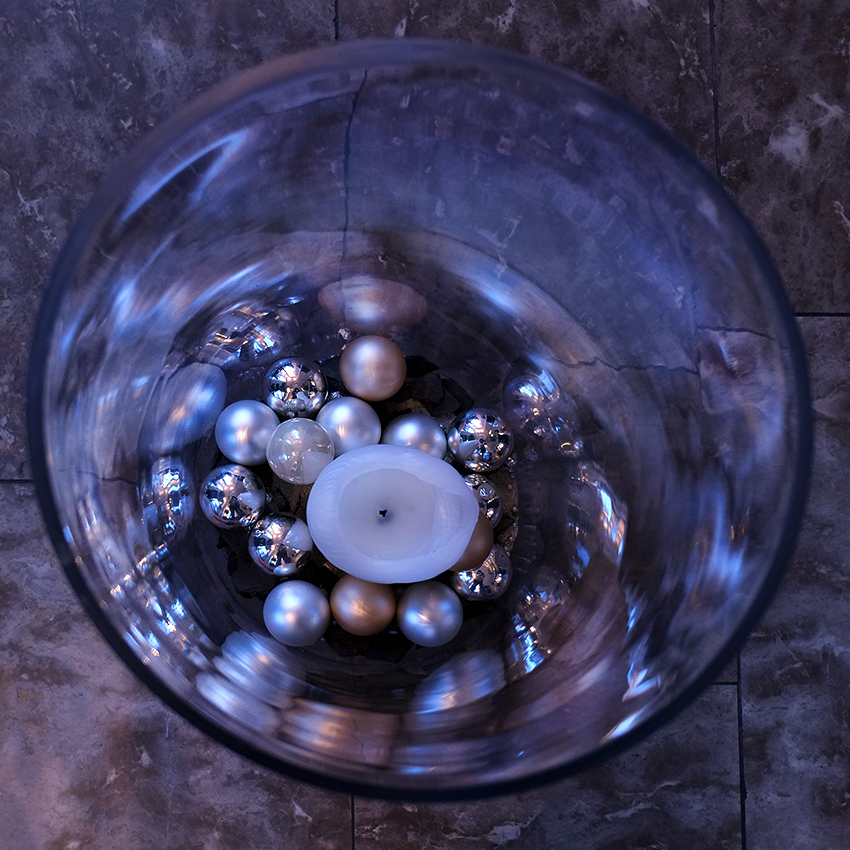 I took my obligatory art shot in the lobby of our hotel before we headed out the door. We had a train to catch.
I took my obligatory art shot in the lobby of our hotel before we headed out the door. We had a train to catch.
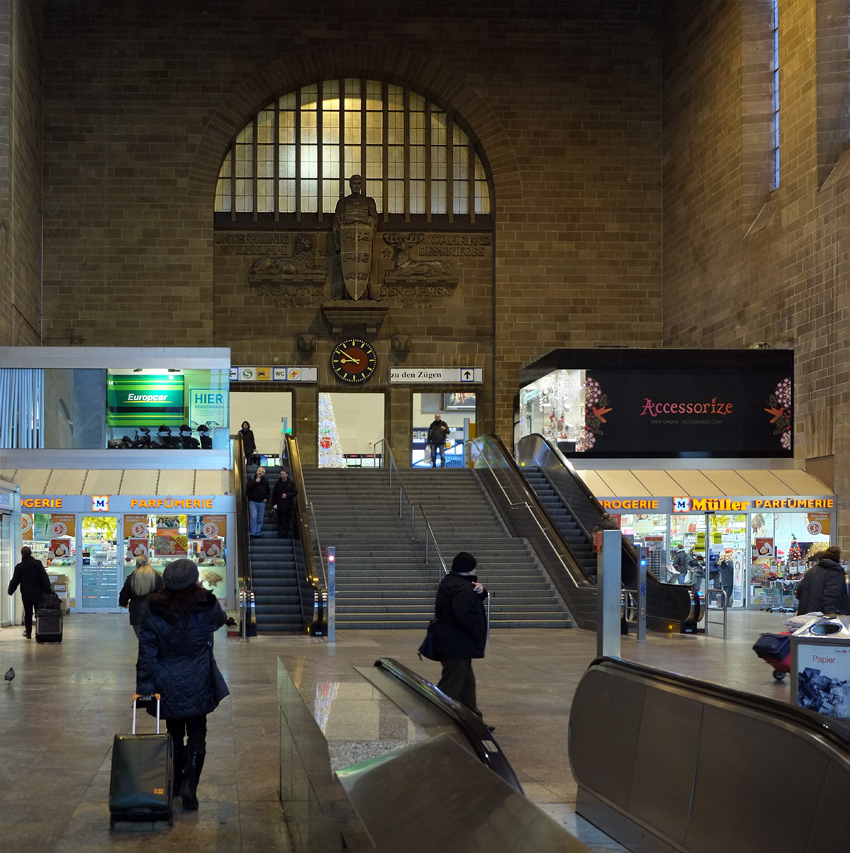 We hustled through the austere beauty of the Stuttgart Hauptbahnof to catch our train (after a quick stop for Starbucks). We would come back through this train station in a few days and then transit to the airport.
We hustled through the austere beauty of the Stuttgart Hauptbahnof to catch our train (after a quick stop for Starbucks). We would come back through this train station in a few days and then transit to the airport.
Aberdeenshire Day Trip: Around Banchory
 Sunday, September 29, 2013 at 4:03AM
Sunday, September 29, 2013 at 4:03AM  I decided not to spend the whole wee-end in my office . . . especially when the weather was still good. We headed out east on North Deeside Road . . .
I decided not to spend the whole wee-end in my office . . . especially when the weather was still good. We headed out east on North Deeside Road . . .
 Our destination was Banchory, about 30 miles west of Aberdeen. When we arrived we took a small road toward the river because we had heard that the salmon were jumping. But, when we arrived at the River Feugh, we could not resist going in for tea and scones at The Falls of Feugh Restaurant. Yummy.
Our destination was Banchory, about 30 miles west of Aberdeen. When we arrived we took a small road toward the river because we had heard that the salmon were jumping. But, when we arrived at the River Feugh, we could not resist going in for tea and scones at The Falls of Feugh Restaurant. Yummy.
 Such a yummy place indeed.
Such a yummy place indeed.
 The river Feugh was a fast and rocky stream.
The river Feugh was a fast and rocky stream.
 We stood on a bridge and some old local people told us that today there was only one large and one small salmon trying to make it up and over the rapids. We saw the large one make a great leap . . . but fail.
We stood on a bridge and some old local people told us that today there was only one large and one small salmon trying to make it up and over the rapids. We saw the large one make a great leap . . . but fail.
 Our next destination was a farm store that had been recommended to us in the area. We took to a country lane dotted with wonderful cottages here and there.
Our next destination was a farm store that had been recommended to us in the area. We took to a country lane dotted with wonderful cottages here and there.
 Several people had been talking to us about the charms of the rural farm stores. Finzean Estate Farm Store was nondescript on the outside.
Several people had been talking to us about the charms of the rural farm stores. Finzean Estate Farm Store was nondescript on the outside.
 But on the inside it was a food photographer's dream!
But on the inside it was a food photographer's dream!
 The low, flat light was perfect for capturing the subtle shades and shifts of light.
The low, flat light was perfect for capturing the subtle shades and shifts of light.
 Yes, I have to say it, a veritable cornucopia!
Yes, I have to say it, a veritable cornucopia!
 I was taking so many photos of the vegetables that I actually drew an interested crowd of onlookers!
I was taking so many photos of the vegetables that I actually drew an interested crowd of onlookers!
 We bought parsnips, hot peppers, and garlic.
We bought parsnips, hot peppers, and garlic.
 I love to photograph vegetables. What's wrong with me?
I love to photograph vegetables. What's wrong with me?
 Just give me a cabbage and some good light . . . .
Just give me a cabbage and some good light . . . .
 . . . and I'll even shoot in black in white, in spite of the color!
. . . and I'll even shoot in black in white, in spite of the color!
 They had more for sale than food . . .
They had more for sale than food . . .
 . . . lots of honest, simple items.
. . . lots of honest, simple items.
 We left the farm store and went on down the country lanes of Aberdeenshire. I love how people name their homes.
We left the farm store and went on down the country lanes of Aberdeenshire. I love how people name their homes.
 We drove deeper into rural Aberdeenshire and were rewarded with a blanket of yellow ferns along the road.
We drove deeper into rural Aberdeenshire and were rewarded with a blanket of yellow ferns along the road.
 Blue grey light on the white beech bark above a carpet of yellow.
Blue grey light on the white beech bark above a carpet of yellow.
 It was a perfect day to be in the forest of Abedeenshire, Scotland.
It was a perfect day to be in the forest of Abedeenshire, Scotland.
 I have never seen this yellowing fern array in my life. Very beautiful!
I have never seen this yellowing fern array in my life. Very beautiful!
 We have equipped ourselves with the perfect road trip vehicle: the VW Taureg AWD 2.0 Diesel . . . 50+ MPG!
We have equipped ourselves with the perfect road trip vehicle: the VW Taureg AWD 2.0 Diesel . . . 50+ MPG!
 We meandered around on the small Aberdeenshire country roads until we came to the Potarch Hotel. We went in had had a wonderful lunch.
We meandered around on the small Aberdeenshire country roads until we came to the Potarch Hotel. We went in had had a wonderful lunch.
 After lunch we walked fifty meters to the stone bridge over the upper River Dee. It was a perfect end-of-summer day.
After lunch we walked fifty meters to the stone bridge over the upper River Dee. It was a perfect end-of-summer day.
 A perfect day for some fly fishing on the River Dee.
A perfect day for some fly fishing on the River Dee.
 Aberdeenshire on the brink of Autumn.
Aberdeenshire on the brink of Autumn.
 We followed a nearby sign pointing to a "Forest Walk." We thought we were going to be walking in the wilderness, but instead the path followed the road, albeit a wooded road.
We followed a nearby sign pointing to a "Forest Walk." We thought we were going to be walking in the wilderness, but instead the path followed the road, albeit a wooded road.
 There were some very sweet cottages along the way.
There were some very sweet cottages along the way.
 I love these old walls being reclaimed by Nature. There is know way to know how old these walls are . . . perhaps from Medieval times.
I love these old walls being reclaimed by Nature. There is know way to know how old these walls are . . . perhaps from Medieval times.
 One of the great things about forest walks in Europe is coming across a vestige of some older era . . . slowly dissolving back into the earth.
One of the great things about forest walks in Europe is coming across a vestige of some older era . . . slowly dissolving back into the earth.
 Although it was the fifth day of Autumn, there were still a few summer blooms hanging on.
Although it was the fifth day of Autumn, there were still a few summer blooms hanging on.
 The proverbial late bloomer!
The proverbial late bloomer!
 Summer's end: time to disperse seeds.
Summer's end: time to disperse seeds.
 There were some fine large mushrooms pushing their way up though the overgrown forest floor too.
There were some fine large mushrooms pushing their way up though the overgrown forest floor too.
 These black mushrooms looked positively DANGEROUS! I was scared to get too close.
These black mushrooms looked positively DANGEROUS! I was scared to get too close.
 A forest is a living thing: it takes life from parts of itself when they die.
A forest is a living thing: it takes life from parts of itself when they die.
 We saw these red "berries' everywhere, but knew, somehow, that you could not eat them. How do we know this?
We saw these red "berries' everywhere, but knew, somehow, that you could not eat them. How do we know this?
 Evidence of a job well done.
Evidence of a job well done.
 We left the beautiful Aberdeenshire forest rivulets, flowers, and treed behind . . . .
We left the beautiful Aberdeenshire forest rivulets, flowers, and treed behind . . . .
 . . . and bid farewell to our little friend the inch worm (he better hurry: winter is coming!), and drove to Banchory.
. . . and bid farewell to our little friend the inch worm (he better hurry: winter is coming!), and drove to Banchory.
 We arrived in Banchory in late afternoon under greying skies.
We arrived in Banchory in late afternoon under greying skies.
 It was a Saturday and lots of people seemed to have driven out from Aberdeen for the small town charm.
It was a Saturday and lots of people seemed to have driven out from Aberdeen for the small town charm.
 We did a little shopping ourselves in this butchery that seems little changed from its 1921 origins. We bought the perfect mint sauce for lamb.
We did a little shopping ourselves in this butchery that seems little changed from its 1921 origins. We bought the perfect mint sauce for lamb.
 One last look around town to discover this marvelous flower shop before driving home. We only put 30 miles on the odometer. There is so much to see that is near to Aberdeen. We are really loving exploring the city and the region. Fortunately we are having one of the driest and warmest summers anyone around her can remember. We plan on taking advantage of every minute of it.
One last look around town to discover this marvelous flower shop before driving home. We only put 30 miles on the odometer. There is so much to see that is near to Aberdeen. We are really loving exploring the city and the region. Fortunately we are having one of the driest and warmest summers anyone around her can remember. We plan on taking advantage of every minute of it.
One Week in India
 Monday, October 29, 2012 at 8:47PM
Monday, October 29, 2012 at 8:47PM A Journey In Four Parts. ___________________________________________________________________________________________________
Part One: Fort Cochin.
 After a complex overnight flight from Bangkok to Mumbai where we waited over eight hours for our connection to Cochin (go here for map and description of Fort Kochi), we were happy to arrive at the Rossetta Wood Castle Hotel.
After a complex overnight flight from Bangkok to Mumbai where we waited over eight hours for our connection to Cochin (go here for map and description of Fort Kochi), we were happy to arrive at the Rossetta Wood Castle Hotel.
 The Rossetta Hotel was built in 1705. It was cheap and very comfortable. It was located a stones throw from the sea and the old Dutch promenade.
The Rossetta Hotel was built in 1705. It was cheap and very comfortable. It was located a stones throw from the sea and the old Dutch promenade.
 The room was air-conditioned, simple, and had a wonderful old tropical musty smell which reminded me of Africa for some reason.
The room was air-conditioned, simple, and had a wonderful old tropical musty smell which reminded me of Africa for some reason.
 After a brief nap, I headed out to take a stroll along the old promenade. It was a Sunday, so there were lots of people ambling along the path. I was able to indulge my obsession with peddler's carts.
After a brief nap, I headed out to take a stroll along the old promenade. It was a Sunday, so there were lots of people ambling along the path. I was able to indulge my obsession with peddler's carts.
 As the sun began to set, the temperature drop, the crowds showed up . . . and so did the ice cream vendors with their bright and shiny carts.
As the sun began to set, the temperature drop, the crowds showed up . . . and so did the ice cream vendors with their bright and shiny carts.
 The snack vendors also gathered in threes and fours . . . happy to pose. Snackage was everywhere to be had! The mercury vapor street lights cast a strange yellow pallor over everything . . . marvelously contrasted with the deep blues of the sunset sky.
The snack vendors also gathered in threes and fours . . . happy to pose. Snackage was everywhere to be had! The mercury vapor street lights cast a strange yellow pallor over everything . . . marvelously contrasted with the deep blues of the sunset sky.
 My first sunset in India in 20 years was shaping up to be a good one. Many people were gathering on a jetty to take it in. It really was a beautiful evening.
My first sunset in India in 20 years was shaping up to be a good one. Many people were gathering on a jetty to take it in. It really was a beautiful evening.
 I love these street peddlers and their ice cream carts at sunset. There is something both exciting about them (a child's gauging their prospects of getting an ice cream) and forlorn . . .
I love these street peddlers and their ice cream carts at sunset. There is something both exciting about them (a child's gauging their prospects of getting an ice cream) and forlorn . . .
 The local people referred to these contraptions as "Chinese nets."
The local people referred to these contraptions as "Chinese nets."
 There were many of these Lazza Ice Cream carts. Apparently the Lazza Salesman of the Year had been in town with a line of credit and a truck full of carts! I never saw anybody actually purchase an ice cream from these guys.
There were many of these Lazza Ice Cream carts. Apparently the Lazza Salesman of the Year had been in town with a line of credit and a truck full of carts! I never saw anybody actually purchase an ice cream from these guys.
 Night snackage.
Night snackage.
 Nicely arrayed Indian night snackage.
Nicely arrayed Indian night snackage.
 Sticking your head under the roof of one of these night snackage mobile sales units was like peeking through a portal that opened up onto an alternate universe. No kidding.
Sticking your head under the roof of one of these night snackage mobile sales units was like peeking through a portal that opened up onto an alternate universe. No kidding.
 In some places several peddlars had circled their carts, like a barrier against the immensity of the night.
In some places several peddlars had circled their carts, like a barrier against the immensity of the night.
 Cochin has had a large Jewish population since the 2nd century. There are many lovely old Jewish merchants homes around Cochin. Some, like this one, have been made into restaurants. My friends Bud and Allan joined me for a sumptuous meal here.
Cochin has had a large Jewish population since the 2nd century. There are many lovely old Jewish merchants homes around Cochin. Some, like this one, have been made into restaurants. My friends Bud and Allan joined me for a sumptuous meal here.
 We walked around the old town and marvelled at Cochin's rich history. Ah! It seems the Lazza salesman had a unit that fits nicely in the back of a Tuk-tuk truck.
We walked around the old town and marvelled at Cochin's rich history. Ah! It seems the Lazza salesman had a unit that fits nicely in the back of a Tuk-tuk truck.
 I woke up very early the next morning to take a stroll around and take some photos before the houseboat company came to pick us up. The sky was overcast . . . not ideal for photography, but it didn't matter. Cochin's 14th-18th century high point of development was evident everywhere.
I woke up very early the next morning to take a stroll around and take some photos before the houseboat company came to pick us up. The sky was overcast . . . not ideal for photography, but it didn't matter. Cochin's 14th-18th century high point of development was evident everywhere.
 Cochin saw Middle eastern Jewish and Islamic settlement, followed by Portugese and Dutch colonial settlements, and eventually the British Raj. The Dutch-built St. Francis Church, 1882, is one of the newer churches here.
Cochin saw Middle eastern Jewish and Islamic settlement, followed by Portugese and Dutch colonial settlements, and eventually the British Raj. The Dutch-built St. Francis Church, 1882, is one of the newer churches here.
 The Dutch left behind some nice architecture . . . .
The Dutch left behind some nice architecture . . . .
 . . . and that's not all the Dutch left behind! I LOVED this sign: How far is "O Km"? Yes, well, I guess a cemetery would be "God's own country" if you believed in that kind of thing. Actually, "God's Own Country" was a phrase coined by the Kerala Tourist Authority . . . oh well. I went to God's Own Country, er, I mean, the old Dutch cemetary, but it was locked. It was founded in 1724.
. . . and that's not all the Dutch left behind! I LOVED this sign: How far is "O Km"? Yes, well, I guess a cemetery would be "God's own country" if you believed in that kind of thing. Actually, "God's Own Country" was a phrase coined by the Kerala Tourist Authority . . . oh well. I went to God's Own Country, er, I mean, the old Dutch cemetary, but it was locked. It was founded in 1724.
 A four-hundred year old wall has a history.
A four-hundred year old wall has a history.
 I was in street peddler's cart HEAVEN! This one definitely ranks in my all time second decile!
I was in street peddler's cart HEAVEN! This one definitely ranks in my all time second decile!
 Cochin is a side trip on the global tourist map. It has been discovered. As such, there have been a number of the old colonial mansions restored and converted into up-scale "boutique" hotels.
Cochin is a side trip on the global tourist map. It has been discovered. As such, there have been a number of the old colonial mansions restored and converted into up-scale "boutique" hotels.
 This boutique hotel was a bit over the top: shades of Bali . . . too much of a shade of Bali. I preferred the simple honesty of the Rossetta.
This boutique hotel was a bit over the top: shades of Bali . . . too much of a shade of Bali. I preferred the simple honesty of the Rossetta.
 Kerala is a "communist" state within India. I use quotations because it is a very home-grown communism without any foreign affiliations. The government here is concerned with "social uplift" as many here told me.
Kerala is a "communist" state within India. I use quotations because it is a very home-grown communism without any foreign affiliations. The government here is concerned with "social uplift" as many here told me.
 My morning walkabout led me through the wondrous damp streets of early morning Fort Cochin, India.
My morning walkabout led me through the wondrous damp streets of early morning Fort Cochin, India.
 Fort Cochin has many old forts, vestiges of the various colonial interlopers. My love of dilapidation, corrugation, and old walls was met here in spades!
Fort Cochin has many old forts, vestiges of the various colonial interlopers. My love of dilapidation, corrugation, and old walls was met here in spades!
 Of course the biggest and nicest house in the city is the Bishops House. One can imagine tea with the Viceroy and Bishop on the veranda not long after its 1557 founding. Those pesky Christians have been at it for a long time.
Of course the biggest and nicest house in the city is the Bishops House. One can imagine tea with the Viceroy and Bishop on the veranda not long after its 1557 founding. Those pesky Christians have been at it for a long time.
 There are blocks and blocks of old Dutch homes in Fort Cochin.
There are blocks and blocks of old Dutch homes in Fort Cochin.
 There are many churches in Kerala, but the Santa Cruz Cathedral was particularly magnificent. I caught convent dwellers skipping off to school.
There are many churches in Kerala, but the Santa Cruz Cathedral was particularly magnificent. I caught convent dwellers skipping off to school.
 Rural folk stepping into the interior of the Santa Cruz Cathedral for the first time must have been mighty impressed.
Rural folk stepping into the interior of the Santa Cruz Cathedral for the first time must have been mighty impressed.
 Those early church architects sure knew how to use natural light. Yummie.
Those early church architects sure knew how to use natural light. Yummie.
 "Forgive Them For They Know Not What They Do" -- a 16th Century European Christian world view.
"Forgive Them For They Know Not What They Do" -- a 16th Century European Christian world view.
 The Ambassador was manufactured in India for oer 50 years virtually unchanged. Lovely car.
The Ambassador was manufactured in India for oer 50 years virtually unchanged. Lovely car.
 It seemed like every corner I walked around that morning presented a fantastic wall in the process of allowing time and Nature make it into Art.
It seemed like every corner I walked around that morning presented a fantastic wall in the process of allowing time and Nature make it into Art.
 I was stopped in my tracks . . in stunned silence at the sight of this building . . . telling its history in light and color. I had to investigate . . . and to study it photographically. Graffiti upon graffiti, moss upon moss, paint upon paint, water stains upon water stains.
I was stopped in my tracks . . in stunned silence at the sight of this building . . . telling its history in light and color. I had to investigate . . . and to study it photographically. Graffiti upon graffiti, moss upon moss, paint upon paint, water stains upon water stains.
 The colors of time and nature violated by a grey cement window repair.
The colors of time and nature violated by a grey cement window repair.
 The same building: wall and window.
The same building: wall and window.
 Window only. Not just a window.
Window only. Not just a window.
 How to frame this window? What was this building used for?
How to frame this window? What was this building used for?
 I walked around the corner and discovered that I had been photographing the old wing of the Cochin Secondary School, abandoned in 1901 when this new structure was built.
I walked around the corner and discovered that I had been photographing the old wing of the Cochin Secondary School, abandoned in 1901 when this new structure was built.
 It was getting near 9:00am, so I rushed back to the hotel, only stopping when a wall called to me. ("Doctor, the walls are talking to me!")
It was getting near 9:00am, so I rushed back to the hotel, only stopping when a wall called to me. ("Doctor, the walls are talking to me!")
 Was this a stain, or a Rorschach of the city's history?
Was this a stain, or a Rorschach of the city's history?
 I think of these old Cochin walls as half way between their erection, and being discovered as ancient finds by some future archeologist.
I think of these old Cochin walls as half way between their erection, and being discovered as ancient finds by some future archeologist.
 I snapped this last wall, which seemed to have gladly given itself over to worlds upon it, before arriving at the hotel just in time for a quick breakfast and then on to the next adventure on the houseboat.
I snapped this last wall, which seemed to have gladly given itself over to worlds upon it, before arriving at the hotel just in time for a quick breakfast and then on to the next adventure on the houseboat.
FORT COCHIN REVISITED
 Actually, we stayed in Fort Cochin twice: once when we arrived, and once when we returned from the three-day houseboat cruise in the Appleby backwaters. On our way back from the houseboat tour, our driver stopped off at some of the local tourist hot spots . . . . where we weren't the only tourists. With 1,000,000,000 people living in India, and 300,000,000 of them living at or above a middle class life style, there are a lot of Indian tourists. And good for them. That is the 16th Century Synagogue in the background.
Actually, we stayed in Fort Cochin twice: once when we arrived, and once when we returned from the three-day houseboat cruise in the Appleby backwaters. On our way back from the houseboat tour, our driver stopped off at some of the local tourist hot spots . . . . where we weren't the only tourists. With 1,000,000,000 people living in India, and 300,000,000 of them living at or above a middle class life style, there are a lot of Indian tourists. And good for them. That is the 16th Century Synagogue in the background.
 Fort Cochin has had a large Jewish presence since the 2nd Century (!).
Fort Cochin has had a large Jewish presence since the 2nd Century (!).
 The Paradesi Synagogue. Imagine the wonderful minds that have crossed through this doorway for the past 500 years. The Synagogue was closed due to mourning for a recently departed member of this close knit community.
The Paradesi Synagogue. Imagine the wonderful minds that have crossed through this doorway for the past 500 years. The Synagogue was closed due to mourning for a recently departed member of this close knit community.
 The ancient Fort Kochi synagogue. The street signs in the area declared, "Jewtown."
The ancient Fort Kochi synagogue. The street signs in the area declared, "Jewtown."
 My infatuation with street peddler's carts was satisfied at another tourist stop (an old Prince's palace): The Digital Cart! Notice the sign touting the availability of "Memory Cards, Digital Camera Cards, Batteries . . . ."! The times they are a'changin' INDEED!
My infatuation with street peddler's carts was satisfied at another tourist stop (an old Prince's palace): The Digital Cart! Notice the sign touting the availability of "Memory Cards, Digital Camera Cards, Batteries . . . ."! The times they are a'changin' INDEED!
 After we returned to our hotel, I went walkabout and discovered this restored-for-tourists 1880s jail.
After we returned to our hotel, I went walkabout and discovered this restored-for-tourists 1880s jail.
 The former occupants of this jail cell may, or may not have appreciated the marvelous play of light and shadow.
The former occupants of this jail cell may, or may not have appreciated the marvelous play of light and shadow.
 I came across these shade-dwelling Tuk-Tuk driers who consented to a photograph . . .
I came across these shade-dwelling Tuk-Tuk driers who consented to a photograph . . .
 . . . and since I was hot and tired, and Fort Cochin is kind of spread out, I engaged Mohammed for an afternoon's city tour.
. . . and since I was hot and tired, and Fort Cochin is kind of spread out, I engaged Mohammed for an afternoon's city tour.
 It was great idea to have hired a personal Tuk-Tuk. Mohammed would stop whenever I saw an old window . . .
It was great idea to have hired a personal Tuk-Tuk. Mohammed would stop whenever I saw an old window . . .
 . . . or a photogenic old street stall.
. . . or a photogenic old street stall.
 Even in its dilapidation, there is Old World Charm about Fort Cochin.
Even in its dilapidation, there is Old World Charm about Fort Cochin.
 Mohammed decided I needed to see that there were all kinds of religions practiced in Fort Cochin, and they all got along "without trouble." He brought me first to a Jain temple. Jainism teaches non-violence to all living things and non-attachment and non aversion to the world.
Mohammed decided I needed to see that there were all kinds of religions practiced in Fort Cochin, and they all got along "without trouble." He brought me first to a Jain temple. Jainism teaches non-violence to all living things and non-attachment and non aversion to the world.
 Pigeons are not fools! They figured out the safest place in the city was in the yard of the non-violent Jain Temple.
Pigeons are not fools! They figured out the safest place in the city was in the yard of the non-violent Jain Temple.
 The grounds of the Jain Temple were extremely peaceful . . . perhaps a little too peaceful for this sleeping Jian devotee.
The grounds of the Jain Temple were extremely peaceful . . . perhaps a little too peaceful for this sleeping Jian devotee.
 Our next stop was to be one of the Hindu Temples, but first we had to stop at a fruit market area . . .
Our next stop was to be one of the Hindu Temples, but first we had to stop at a fruit market area . . .
 . . . where it happened Mohammed had a cousin in the actual fruit business. What a coincidence. I bought a bag of very delicious LOCAL oranges.
. . . where it happened Mohammed had a cousin in the actual fruit business. What a coincidence. I bought a bag of very delicious LOCAL oranges.
 There were many, many small shops like this one . . . . where the owners seemed only to earn enough for a subsistence life style. No greed, no hurrying about.
There were many, many small shops like this one . . . . where the owners seemed only to earn enough for a subsistence life style. No greed, no hurrying about.
 Along our route to the Hindu Temple, these local beauties asked me to take their photo.
Along our route to the Hindu Temple, these local beauties asked me to take their photo.
 I suspected this old woodcutter was snot receiving enough to pay for the calories he needed for the hard work he did every day.
I suspected this old woodcutter was snot receiving enough to pay for the calories he needed for the hard work he did every day.
 A well fed Fort Cochin construction worker.
A well fed Fort Cochin construction worker.
 One of the old Fort Cochin Hindu temples . . . fantastic.
One of the old Fort Cochin Hindu temples . . . fantastic.
 These young temple dwellers saw that I had a camera and demanded a photograph. I obliged. These children seemed very creepy to me . . . like they were a special kind of BEING one might see in a science fiction movie: I suspected they were perhaps 400-500 years old by the way they acted and looked at me.
These young temple dwellers saw that I had a camera and demanded a photograph. I obliged. These children seemed very creepy to me . . . like they were a special kind of BEING one might see in a science fiction movie: I suspected they were perhaps 400-500 years old by the way they acted and looked at me.
 Some of the doors in the interior of this temple appeared very old. I took a lot of Old Door photos . . . maybe I should do a book titled, The Old Doors of Fort Cochin, India.
Some of the doors in the interior of this temple appeared very old. I took a lot of Old Door photos . . . maybe I should do a book titled, The Old Doors of Fort Cochin, India.
 This would make a nice cover photo for my book on Cochin Doors. My Tuk-Tuk, driver, Mohammed, got into my obsession with doors too . . . he liked the old doors too and took me to several amazing examples.
This would make a nice cover photo for my book on Cochin Doors. My Tuk-Tuk, driver, Mohammed, got into my obsession with doors too . . . he liked the old doors too and took me to several amazing examples.
 Yes, Mohammed had been hoping to meet a tourist like me to share his love of old doors. What luck!
Yes, Mohammed had been hoping to meet a tourist like me to share his love of old doors. What luck!
 From the simple to the elaborate, I was them all . . . and was very happy about it too.
From the simple to the elaborate, I was them all . . . and was very happy about it too.
 I would love one day to take a very large format camera to photograph these doors . . . and then print them life size . . . . to stand in front of these entryways, with its history so visible, is a real joy.
I would love one day to take a very large format camera to photograph these doors . . . and then print them life size . . . . to stand in front of these entryways, with its history so visible, is a real joy.
 Mohammed was not shy about posing in front of these old doors either. It was good to have a model handy. Maybe he has done this before?
Mohammed was not shy about posing in front of these old doors either. It was good to have a model handy. Maybe he has done this before?
 We went to an old Portuguese-era warehouse and ran into this door: No photography inside. Good thing I do not read Hindi (actually I do) . . . .
We went to an old Portuguese-era warehouse and ran into this door: No photography inside. Good thing I do not read Hindi (actually I do) . . . .
 A forbidden photograph: inside the old Portuguese-era (16th century) warehouse courtyard, now used as a dried ginger gleaning and sorting facility . . .
A forbidden photograph: inside the old Portuguese-era (16th century) warehouse courtyard, now used as a dried ginger gleaning and sorting facility . . .
 I can see why they might not want photographs in here . . . it was down right Medieval.
I can see why they might not want photographs in here . . . it was down right Medieval.
 A [surprised] Fort Cochin ginger gleaner.
A [surprised] Fort Cochin ginger gleaner.
 I asked this aging ginger gleaner if I could photograph her and she struck this pose for me.
I asked this aging ginger gleaner if I could photograph her and she struck this pose for me.
 The results of all that ginger gleaning.
The results of all that ginger gleaning.
 The ginger facility also housed an Everything Imaginable Made From Ginger To Be Sold To Tourists shop. Yes, it was right through that green door Mohammed is leaning next to. What color! We went in, but I did not buy anything . . . it was getting cloudy, and I wanted to see more of Old Fort Cochin.
The ginger facility also housed an Everything Imaginable Made From Ginger To Be Sold To Tourists shop. Yes, it was right through that green door Mohammed is leaning next to. What color! We went in, but I did not buy anything . . . it was getting cloudy, and I wanted to see more of Old Fort Cochin.
 I loved the ambience of this town!
I loved the ambience of this town!
 Well, not all of Fort Cochin was pleasing. I am often a little angered when I see Christian churches outside Europe, and I felt the same way in The Congo. Why spread this nutball idea around the world like it was the privelaged discourse to end all discourse?
Well, not all of Fort Cochin was pleasing. I am often a little angered when I see Christian churches outside Europe, and I felt the same way in The Congo. Why spread this nutball idea around the world like it was the privelaged discourse to end all discourse?
 As Christianity, Islam, and Judaism are sects of the same religion, I guess I was kind of glad when Mohammed said I could not enter his own Mosque.
As Christianity, Islam, and Judaism are sects of the same religion, I guess I was kind of glad when Mohammed said I could not enter his own Mosque.
 An amazing structure. I was struck by how a lack of general building maintenance could produce such beauty. It is important to be reminded of the impermanence of our human existence, and these decaying structures, like the non-linearity of Bangkok (my home), are excellent reminders that humankind is not on some kind of preordained teleological journey towards perfection.
An amazing structure. I was struck by how a lack of general building maintenance could produce such beauty. It is important to be reminded of the impermanence of our human existence, and these decaying structures, like the non-linearity of Bangkok (my home), are excellent reminders that humankind is not on some kind of preordained teleological journey towards perfection.
 The television posted bill is just priceless. It looks like an enlargement of some old fashioned computer clip-art. Nice.
The television posted bill is just priceless. It looks like an enlargement of some old fashioned computer clip-art. Nice.
 If you have snooped around my blog you know that corrugation and dilapidation are among my favorite themes . . . . so I couldn't resist when I saw this masterpiece of Corrugated Art.
If you have snooped around my blog you know that corrugation and dilapidation are among my favorite themes . . . . so I couldn't resist when I saw this masterpiece of Corrugated Art.
 I am sometimes concerned that I only show the interesting or amazing sights of places I visit, overlooking the reality of the mundane day-to-day life of a place. I hope I don't: my intent is to elevate the simple and overlooked into a state of the supramundane in an attempt to blast false, discursively constructed meta-narratives and false hierarchies away. A street in the Islamic quarter of Fort Cochin, Kerala, India.
I am sometimes concerned that I only show the interesting or amazing sights of places I visit, overlooking the reality of the mundane day-to-day life of a place. I hope I don't: my intent is to elevate the simple and overlooked into a state of the supramundane in an attempt to blast false, discursively constructed meta-narratives and false hierarchies away. A street in the Islamic quarter of Fort Cochin, Kerala, India.
 My love of old windows and doors is only exceeded by sealed-up old windows and doors. Why? Maybe I would benefit from some Gestalt psychotherapy . . . . I went back to the hotel after this, figuring I would never get a better photo on the entire trip.
My love of old windows and doors is only exceeded by sealed-up old windows and doors. Why? Maybe I would benefit from some Gestalt psychotherapy . . . . I went back to the hotel after this, figuring I would never get a better photo on the entire trip.
 My racing buddies, Bud and Allan, and I spent our last evening in Fort Cochin strolling the seaside promenade.
My racing buddies, Bud and Allan, and I spent our last evening in Fort Cochin strolling the seaside promenade.
 The cooks at our hotel recommended we go an purchase some fresh fish that they would cook any way we liked. Instead we asked if they could pick one out for us. They did, and cooked one of the most delicious meals I have ever had! After dinner we found the source of the delicious fish.
The cooks at our hotel recommended we go an purchase some fresh fish that they would cook any way we liked. Instead we asked if they could pick one out for us. They did, and cooked one of the most delicious meals I have ever had! After dinner we found the source of the delicious fish.
 As it turned out, the night fish stalls serviced all the hotels and guest houses of Fort Cochin, all of whom asked their guests if they wanted to purchase fresh fish that they would then cook however you would want it.
As it turned out, the night fish stalls serviced all the hotels and guest houses of Fort Cochin, all of whom asked their guests if they wanted to purchase fresh fish that they would then cook however you would want it.
 We had to wake early the next morning to catch a flight to New Delhi, so this was the last photo I took in Fort Cochin, Kerala, India. What a wonderful place to visit.
We had to wake early the next morning to catch a flight to New Delhi, so this was the last photo I took in Fort Cochin, Kerala, India. What a wonderful place to visit.
 OK, this was the last photo in Cochin. This inibriated, but friendly, fellow wished to befriend us by engaging in a conversation that none of us could understand, including him, I believe.
OK, this was the last photo in Cochin. This inibriated, but friendly, fellow wished to befriend us by engaging in a conversation that none of us could understand, including him, I believe.
_______________________________________________________________________________________________________________
Part Two: Kerala Backwater Houseboat Cruise (Three Days & Two Nights)
 Let the lazy cruise begin! As far as we could figure out, this was an exact sister ship to our own houseboat (photo taken from ours).
Let the lazy cruise begin! As far as we could figure out, this was an exact sister ship to our own houseboat (photo taken from ours).
 We boarded our houseboat in a narrow channel that had many other houseboats of varying configurations.
We boarded our houseboat in a narrow channel that had many other houseboats of varying configurations.
 We were happy to set off at a leisurely pace out into the Kerala Backwaters.
We were happy to set off at a leisurely pace out into the Kerala Backwaters.
 This boat, and background, reminded me of my river boat trip up the Congo River 30 years ago. It's the same idea the world over: a river bus.
This boat, and background, reminded me of my river boat trip up the Congo River 30 years ago. It's the same idea the world over: a river bus.
 Other than the other houseboats in the backwaters, there wasn't much human activity to be observed out here. It felt very vast and remote out there.
Other than the other houseboats in the backwaters, there wasn't much human activity to be observed out here. It felt very vast and remote out there.
 Although miles from anywhere, and accessible only by boat, the missionaries had been out here converting souls.
Although miles from anywhere, and accessible only by boat, the missionaries had been out here converting souls.
 Our boatman pulled over a couple of times, mostly to see if we wanted to purchase [very expensive] shrimp or fish. We were very satisfied with the food they were serving and declined. This is our houseboat. Yes, it had a satellite dish, but we never turned on the T.V.
Our boatman pulled over a couple of times, mostly to see if we wanted to purchase [very expensive] shrimp or fish. We were very satisfied with the food they were serving and declined. This is our houseboat. Yes, it had a satellite dish, but we never turned on the T.V.
 This abandoned building must have been a government tariff office as it was located at the junction of two very large canals.
This abandoned building must have been a government tariff office as it was located at the junction of two very large canals.
 We all got off the houseboat here and had fun photographing each other posing in and outside of the old photogenic building.
We all got off the houseboat here and had fun photographing each other posing in and outside of the old photogenic building.
 Bud is a science teacher and pointed out the interesting green expansion streaks on the trunk of this rapidly growing palm.
Bud is a science teacher and pointed out the interesting green expansion streaks on the trunk of this rapidly growing palm.
 Yep, even way the hell out in the backwaters I managed to find an dilapidated old shuttered window to shoot. Lucky me!
Yep, even way the hell out in the backwaters I managed to find an dilapidated old shuttered window to shoot. Lucky me!
 The land around the canals were in various stages of land reclamation: this area was completely reclaimed from the brackish waters as rice fields.
The land around the canals were in various stages of land reclamation: this area was completely reclaimed from the brackish waters as rice fields.
 As can be seen in the background, other land areas had had their salt water pumped out and were soaking in rainwater, which was also pumped out, in an effort to desalinate the soil.
As can be seen in the background, other land areas had had their salt water pumped out and were soaking in rainwater, which was also pumped out, in an effort to desalinate the soil.
 Late October is suppose to be one of the best times for the backwater houseboat trips, but we had thunderstorms with heavy rain every afternoon. The white egrets seemed to be getting ready for the deluge.
Late October is suppose to be one of the best times for the backwater houseboat trips, but we had thunderstorms with heavy rain every afternoon. The white egrets seemed to be getting ready for the deluge.
 All kinds of people use the backwater bus as the only way to get around . . . including some tourists, I see.
All kinds of people use the backwater bus as the only way to get around . . . including some tourists, I see.
 When the storm hit in the late afternoon, the many houseboats headed for the smaller canals to avoid any wave action. You can count 20 houseboats in this photo! We were never out of sight of at least three other boats. It didn't matter.
When the storm hit in the late afternoon, the many houseboats headed for the smaller canals to avoid any wave action. You can count 20 houseboats in this photo! We were never out of sight of at least three other boats. It didn't matter.
 Some of the other houseboats pulled over in the heaviest of the rain . . . . .
Some of the other houseboats pulled over in the heaviest of the rain . . . . .
 . . . but not our pilot! He pushed on, as a reduced speed, throughout the storm.
. . . but not our pilot! He pushed on, as a reduced speed, throughout the storm.
 I would imagine those involved with reclaiming this land were happy to see such a big downpour.
I would imagine those involved with reclaiming this land were happy to see such a big downpour.
 The storm finally broke leaving this amazing afternoon light. I knew we were going to be in for a beautiful sunset.
The storm finally broke leaving this amazing afternoon light. I knew we were going to be in for a beautiful sunset.
 From our upper floor crows nest we could see thunder storms all around.
From our upper floor crows nest we could see thunder storms all around.
 Day gradually turned to night . . . .
Day gradually turned to night . . . .
 . . . the sky turned from a leaden grey to the yellow warmth of golden light.
. . . the sky turned from a leaden grey to the yellow warmth of golden light.
 With the sun setting, our pilot pulled up behind another houseboat to tie up for the night.
With the sun setting, our pilot pulled up behind another houseboat to tie up for the night.
 The sunset was shaping up to be incredible. I put some Indian flute music on the Jambox MusicBar and we all sat back and fell into a mellow stupor, lulled by the beauty of the music and sunset.
The sunset was shaping up to be incredible. I put some Indian flute music on the Jambox MusicBar and we all sat back and fell into a mellow stupor, lulled by the beauty of the music and sunset.
 Stunning.
Stunning.
 Every minute the sunset presented different colors and shades . . .
Every minute the sunset presented different colors and shades . . .
 . . . I became completely indiscriminate in my photo taking . . . running around saying, "WOW! Look at it now!" . . . and clicking a few more shots.
. . . I became completely indiscriminate in my photo taking . . . running around saying, "WOW! Look at it now!" . . . and clicking a few more shots.
 This was directly across the canal from where we had tied up for the night.
This was directly across the canal from where we had tied up for the night.
 After about 50 of these shots I got the idea to create a sequence that would play as a sideshow on this site . . . .
After about 50 of these shots I got the idea to create a sequence that would play as a sideshow on this site . . . .
Each of these would make a great poster. The darker it got, the more lightning we could see in the distant clouds. The night sky was not over.
 After many, many attempts, I finally captured a little snippet of lightning flashing in the distance. It was a magic night.
After many, many attempts, I finally captured a little snippet of lightning flashing in the distance. It was a magic night.
- - - - - - - - - - - - - - - - - - - - - - - - - - - - - - - - - - - - - - -
 I was woken early the next day by the sound of soft splashing outside the houseboat and went out to investigate. Our crew was out trying to net some fish.
I was woken early the next day by the sound of soft splashing outside the houseboat and went out to investigate. Our crew was out trying to net some fish.
 Did I mention that every meal was a gourmet meal? They were not only delicious, but always beautifully presented, like this breakfast feast.
Did I mention that every meal was a gourmet meal? They were not only delicious, but always beautifully presented, like this breakfast feast.
 The construction detail of our houseboat was very intricate . . . and beautiful in the morning light.
The construction detail of our houseboat was very intricate . . . and beautiful in the morning light.
 At around 9:00am our crew cast off and we rejoined our journey on the backwaters of Kerala.
At around 9:00am our crew cast off and we rejoined our journey on the backwaters of Kerala.
 It was a beautiful cool morning, so there qere many more people out on the backwaters in all forms of watercraft.
It was a beautiful cool morning, so there qere many more people out on the backwaters in all forms of watercraft.
 This local fellow looked like he has seen his share of tourists in houseboats invading the serenity of his home.
This local fellow looked like he has seen his share of tourists in houseboats invading the serenity of his home.
 I have no idea what these canalside residents thought of us as we passed . . .
I have no idea what these canalside residents thought of us as we passed . . .
 . . . I hope they saw us as travellers who were there to appreciate the beauty of the natural and manmade world they inhabit.
. . . I hope they saw us as travellers who were there to appreciate the beauty of the natural and manmade world they inhabit.
 A Kerala Huck Finn . . . with a full life ahead of him . . .
A Kerala Huck Finn . . . with a full life ahead of him . . .
 . . . and the knowledge that the government of Kerala is looking after his basic needs.
. . . and the knowledge that the government of Kerala is looking after his basic needs.
 Life along the banks never quit being fascinating to me.
Life along the banks never quit being fascinating to me.
 Having to catch a fish to survive would be very stressful for me.
Having to catch a fish to survive would be very stressful for me.
 It rained on and off during the day . . . but the fishermen kept on fishing.
It rained on and off during the day . . . but the fishermen kept on fishing.
 Almost everyone we saw out in the backwaters were men . . . with these two exceptions.
Almost everyone we saw out in the backwaters were men . . . with these two exceptions.
 Part of our marvelous, and tasty, lunch.
Part of our marvelous, and tasty, lunch.
 The scenes here were timeless . . . like something out of a bygone era . . .
The scenes here were timeless . . . like something out of a bygone era . . .
 Yes, 2012, not 1912 . . .
Yes, 2012, not 1912 . . .
 Some scenes seem to lend themselves to black and white/sepia.
Some scenes seem to lend themselves to black and white/sepia.
 Kerala backwater canal maintenance workmen, circa 2012.
Kerala backwater canal maintenance workmen, circa 2012.
 A nice old launch.
A nice old launch.
 What a wonderful world.
What a wonderful world.
 As evening drew near on the second day, the backwaters opened out into an immense shallows . . .
As evening drew near on the second day, the backwaters opened out into an immense shallows . . .
 . . . . and many fishermen sprinkled themselves about tending their nets.
. . . . and many fishermen sprinkled themselves about tending their nets.
 Our houseboat crew at work in the late afternoon.
Our houseboat crew at work in the late afternoon.
 I the rainy evening we steered into a small canal and tied up in a small village, like many other houseboats.
I the rainy evening we steered into a small canal and tied up in a small village, like many other houseboats.
 After the sun set a number of "party boats" cruised up and down the canal, reminding us of how close we must be to a large population center.
After the sun set a number of "party boats" cruised up and down the canal, reminding us of how close we must be to a large population center.
 We spent a very serene night moored in the backwater canal of Kerala.
We spent a very serene night moored in the backwater canal of Kerala.
 I woke early the next morning to stroll around the small canalside village.
I woke early the next morning to stroll around the small canalside village.
 There was a small Hindu temple in the village and it seemed people had dressed in their finery to attend some kind of special event there.
There was a small Hindu temple in the village and it seemed people had dressed in their finery to attend some kind of special event there.
 The colors in the clothing was devine.
The colors in the clothing was devine.
 After breakfast we motored back out into the open water where I saw this giant houseboat with five bedrooms . . .what a fun party that could be!
After breakfast we motored back out into the open water where I saw this giant houseboat with five bedrooms . . .what a fun party that could be!
 Breakfast.
Breakfast.
 In the last morning we went back up the canal to where we started our journey. This is our crew and the manager of the houseboat company (on left). We had a great three days puttering out and about the inland backwaters.
In the last morning we went back up the canal to where we started our journey. This is our crew and the manager of the houseboat company (on left). We had a great three days puttering out and about the inland backwaters.
_______________________________________________________________________________________________________________
Part Three: Delhi
 We made it to Delhi after the sun had set and took along ride in an old Ambassador taxi to our hotel on this street. Oh My, What Have We Done?!!! You can see our hotel in the background, The Hotel le Roi.
We made it to Delhi after the sun had set and took along ride in an old Ambassador taxi to our hotel on this street. Oh My, What Have We Done?!!! You can see our hotel in the background, The Hotel le Roi.
 This beautiful scene was just down the street from our hotel, the Hotel LeRoi, in Delhi.
This beautiful scene was just down the street from our hotel, the Hotel LeRoi, in Delhi.
 I was fascinated by the street right out in front of our hotel. The Delhi Night Street.
I was fascinated by the street right out in front of our hotel. The Delhi Night Street.
 The street life, the street characters, bathed in the yellowish mercury vapor lights, created a dream world filled with all the stations and predicaments of life . . like a living Ramanaya.
The street life, the street characters, bathed in the yellowish mercury vapor lights, created a dream world filled with all the stations and predicaments of life . . like a living Ramanaya.
 The Delhi street is dusty, noisy, and smelly . . . with the ubiquitous tuktuk responsible for most of it!
The Delhi street is dusty, noisy, and smelly . . . with the ubiquitous tuktuk responsible for most of it!
 The cold lassi looked inviting . . . but . . .
The cold lassi looked inviting . . . but . . .
 . . . I decided on a couple of local Indian oranges from the fruit stand on the left instead.
. . . I decided on a couple of local Indian oranges from the fruit stand on the left instead.
 I walked up and down this street a dozen times in the four days I was in Delhi and never tired of looking and seeing.
I walked up and down this street a dozen times in the four days I was in Delhi and never tired of looking and seeing.
 The mercury vapor street lights varied quite a it in their color tone; some were very bright and yellow, and some were more reddish, like in this scene of a samlor driver night eatery.
The mercury vapor street lights varied quite a it in their color tone; some were very bright and yellow, and some were more reddish, like in this scene of a samlor driver night eatery.
 The Hotel le Roi was just down the street to a warehouse that employed porters late in the night to carry sacks of flour out to waiting trucks. There were always many men sitting on the curb hoping to get some hourly income.
The Hotel le Roi was just down the street to a warehouse that employed porters late in the night to carry sacks of flour out to waiting trucks. There were always many men sitting on the curb hoping to get some hourly income.
 This Delhi night workman gestured to me to take his photo.
This Delhi night workman gestured to me to take his photo.
 I wasn't sure if this was a ladder shop or if there was going to be some high construction nearby.
I wasn't sure if this was a ladder shop or if there was going to be some high construction nearby.
 All dressed up . . .
All dressed up . . .
 This samlor driver sat in this pose for a very long time, lost in time.
This samlor driver sat in this pose for a very long time, lost in time.
 When it got very late, many people pulled out their stashed bed rolls and went to sleep on the sidewalks . . . mainly under the brightest lights they could fin.
When it got very late, many people pulled out their stashed bed rolls and went to sleep on the sidewalks . . . mainly under the brightest lights they could fin.
 Bud and I woke up early, had a pretty good breakfast buffet at the Hotel le Roi, and headed out to see if we could find famous The Red Fort . . . on foot. Armed with a pretty good hotel provided map, we set off for a long walk in the Old Delhi streets. Oh, the things we would see!
Bud and I woke up early, had a pretty good breakfast buffet at the Hotel le Roi, and headed out to see if we could find famous The Red Fort . . . on foot. Armed with a pretty good hotel provided map, we set off for a long walk in the Old Delhi streets. Oh, the things we would see!
 My, my, my . . . . what streets they were! With so many millions living in Delhi, the need for delivery transportation is great. To see ox carts in the middle of a city is something fantastic.
My, my, my . . . . what streets they were! With so many millions living in Delhi, the need for delivery transportation is great. To see ox carts in the middle of a city is something fantastic.
 Some loads you are unlucky as a cycle drayman . . . you need a little help from a freind . . . .
Some loads you are unlucky as a cycle drayman . . . you need a little help from a freind . . . .
 . . . and some loads you get lucky and have to only haul pillow stuffing.
. . . and some loads you get lucky and have to only haul pillow stuffing.
 But mostly the loads were heavy. This looks like a hard life . . . one where you would aks a lot of questions about the nature of existence . . . .
But mostly the loads were heavy. This looks like a hard life . . . one where you would aks a lot of questions about the nature of existence . . . .
 I don't know why a tri-shaw mattress delivery person on the side streets of Old Delhi strikes me as humorous. Pure Novelty?
I don't know why a tri-shaw mattress delivery person on the side streets of Old Delhi strikes me as humorous. Pure Novelty?
 . . . . which is the work of these good fellows, the Sadhus.
. . . . which is the work of these good fellows, the Sadhus.
 I asked with a gesture to my camera if I could make a portrait of these Sadhus and they all nodded their acquiescence.
I asked with a gesture to my camera if I could make a portrait of these Sadhus and they all nodded their acquiescence.
 These Sadhu portraits were taken in a temple not far from our hotel.
These Sadhu portraits were taken in a temple not far from our hotel.
 What's on his mind, I do not know . . . he may have transcended it.
What's on his mind, I do not know . . . he may have transcended it.
 There is the question of volition: "What to do?" I have a pair of shoes just like his.
There is the question of volition: "What to do?" I have a pair of shoes just like his.
 Magnificent affect . . . or, perhaps, affective magnificence.
Magnificent affect . . . or, perhaps, affective magnificence.
 There were holy men sitting around everywhere in this temple . . . I wondered how, and why, they decide on wearing what they are wearing.
There were holy men sitting around everywhere in this temple . . . I wondered how, and why, they decide on wearing what they are wearing.
 These two holy men were studying.
These two holy men were studying.
 This holy man appeared very self-satisfied, that is, if he had a self.
This holy man appeared very self-satisfied, that is, if he had a self.
 I liked this guy . . . and thought of sitting down for a conversion about, you know, everything.
I liked this guy . . . and thought of sitting down for a conversion about, you know, everything.
 We left the temple and headed up and over a train viaduct where we found this man using the bridge railings to dry white string. It seems every single space had been exploited for some human activity.
We left the temple and headed up and over a train viaduct where we found this man using the bridge railings to dry white string. It seems every single space had been exploited for some human activity.
 I could not tell if this guy was a holy man or not. He sat in the shade with a pan out in front of him filled with snacks. He was a snackage merchandiser . . . maybe recently a Sadhu . . . who knows. There is a question of volition.
I could not tell if this guy was a holy man or not. He sat in the shade with a pan out in front of him filled with snacks. He was a snackage merchandiser . . . maybe recently a Sadhu . . . who knows. There is a question of volition.
 Bud and I walked many huours n the small back streets of Old Delhi looking for the Red Fort. After a while it did not really matter if we ever found it . . .
Bud and I walked many huours n the small back streets of Old Delhi looking for the Red Fort. After a while it did not really matter if we ever found it . . .
 . . . there were so many interesting things to see and contemplate.
. . . there were so many interesting things to see and contemplate.
 Every single square meter has been figured out long ago in Delhi. The small space between the doorway and the mobile phone shop has been filled with a small altar . . . complete with two women attendants.
Every single square meter has been figured out long ago in Delhi. The small space between the doorway and the mobile phone shop has been filled with a small altar . . . complete with two women attendants.
 The shoe repairman's buddy stopped in for a chat. I had a warm feeling about the Indians living life out in the civic space.
The shoe repairman's buddy stopped in for a chat. I had a warm feeling about the Indians living life out in the civic space.
 This vegetable hawker was sorting potatoes while clutching his iPhone against his shoulder . . . Deli folk were far from disconnected.
This vegetable hawker was sorting potatoes while clutching his iPhone against his shoulder . . . Deli folk were far from disconnected.
 I stopped to take a photo of the wonderful blue door . . . just as a dray cart full of cement passed in front.
I stopped to take a photo of the wonderful blue door . . . just as a dray cart full of cement passed in front.
 The doors in this part of Delhi were superb: old, unkempt, and with their histories still intact.
The doors in this part of Delhi were superb: old, unkempt, and with their histories still intact.
 The narrow alleyways were full of these touching architectural scenes.
The narrow alleyways were full of these touching architectural scenes.
 Holy men would occasionally pass us by in the small streets.
Holy men would occasionally pass us by in the small streets.
 Along one narrow street, no wider than two meters, a man had converted his home into a temple to Sai Baba, RIP.
Along one narrow street, no wider than two meters, a man had converted his home into a temple to Sai Baba, RIP.
 The Sai Baba temple keeper asked that I take his photograph.
The Sai Baba temple keeper asked that I take his photograph.
 The Sai Baba temple effigy.
The Sai Baba temple effigy.
 The alleys of Old Delhi are winding and lined with doors and passageways. Doors seem to me to tell a mysterious story about the interiors behind them, like a human face.
The alleys of Old Delhi are winding and lined with doors and passageways. Doors seem to me to tell a mysterious story about the interiors behind them, like a human face.
 This door, these stairs, where do they lead?
This door, these stairs, where do they lead?
 A small shop in the depths of Old Delhi . . . where a child grows up beneath colorful balls.
A small shop in the depths of Old Delhi . . . where a child grows up beneath colorful balls.
 A vender of everything deep fried to a golden brown.
A vender of everything deep fried to a golden brown.
 Another Old Delhi alley shop sold these, uh . . . . . you tell me!
Another Old Delhi alley shop sold these, uh . . . . . you tell me!
 An endless number of doors. Somewhere I have a book titled The Doors of Florence, Italy. A book of Old Delhi doors would be equally fascinating, and just as beautiful.
An endless number of doors. Somewhere I have a book titled The Doors of Florence, Italy. A book of Old Delhi doors would be equally fascinating, and just as beautiful.
 Old Delhi windows are not too shabby either . . . I mean they are shabby . . . and wonderful.
Old Delhi windows are not too shabby either . . . I mean they are shabby . . . and wonderful.
 A history of volition writ in wood.
A history of volition writ in wood.
 The look of the place: a Delhi intersection.
The look of the place: a Delhi intersection.
 The look of the place.
The look of the place.
 Bud and I walked up this street.
Bud and I walked up this street.
 Old Delhi felt to me like a city that had been abandoned for centuries and then reinhabited, rather that a place that is undergoing current decay.
Old Delhi felt to me like a city that had been abandoned for centuries and then reinhabited, rather that a place that is undergoing current decay.
 Perhaps a remnant of a lost civilization, dug up, cleaned off, and new paint applied?
Perhaps a remnant of a lost civilization, dug up, cleaned off, and new paint applied?
 I began to notice that in behind all the carts and merchant's tables was an ancient city, full of fabulous architectural detail.
I began to notice that in behind all the carts and merchant's tables was an ancient city, full of fabulous architectural detail.
 This Grand Entry, hidden in plain view, drew my attention. I stopped in for a chat . . .
This Grand Entry, hidden in plain view, drew my attention. I stopped in for a chat . . .
 . . . and met the great-grandson of this remarkable building's builder, whose visage was left in stone at the entry.
. . . and met the great-grandson of this remarkable building's builder, whose visage was left in stone at the entry.
 Delhi maters.
Delhi maters.
 Mother and son shopping.
Mother and son shopping.
 With so many religions and sects in Delhi, we figured that there had to be some kid of holy day almost every day . . . we hoped that would explain these painted goats . . .
With so many religions and sects in Delhi, we figured that there had to be some kid of holy day almost every day . . . we hoped that would explain these painted goats . . .
 . . . and these boys riding backwards on a spotted camel. We ran into these knuckleheads a couple of times in the Red Fort neighborhood . . . hooting it up!
. . . and these boys riding backwards on a spotted camel. We ran into these knuckleheads a couple of times in the Red Fort neighborhood . . . hooting it up!
 The shops immediately around the Red Fort were primarily auto and truck parts related. This red-bearded vendor specialized in springs . . . and springs . . .
The shops immediately around the Red Fort were primarily auto and truck parts related. This red-bearded vendor specialized in springs . . . and springs . . .
 . . . and springs.
. . . and springs.
 Whiling the hot afternoon hours away in the Red Fort guardhouse.
Whiling the hot afternoon hours away in the Red Fort guardhouse.
 One side of The Red Fort was lined with used auto parts shops.
One side of The Red Fort was lined with used auto parts shops.
 A well-dressed tasseled string vendor perched on a Vespa seat talking on his mobile phone.
A well-dressed tasseled string vendor perched on a Vespa seat talking on his mobile phone.
 This fellow was either preaching something the folks around there had heard already, or he was a ranter. Nobody paid him any attention . . . except me.
This fellow was either preaching something the folks around there had heard already, or he was a ranter. Nobody paid him any attention . . . except me.
 We eventually found the Red Fort . . .
We eventually found the Red Fort . . .
 . . . but The Red Fort was closed to non-Muslims for two hours. We contemplated coming back.
. . . but The Red Fort was closed to non-Muslims for two hours. We contemplated coming back.
 The Red Fort is a magnificent structure. It was a shame we could not get inside.
The Red Fort is a magnificent structure. It was a shame we could not get inside.
 Women were also not let in The Red Fort and instead sat on the steps.
Women were also not let in The Red Fort and instead sat on the steps.
 The view from the Red Fort looking into the chaos of Old Delhi.
The view from the Red Fort looking into the chaos of Old Delhi.
 After grumbling about the closed Red Fort, we decided to walk a 360 around the structure and come back . . . so we headed back out into The Delhi Street.
After grumbling about the closed Red Fort, we decided to walk a 360 around the structure and come back . . . so we headed back out into The Delhi Street.
 There was an Muslim market along one side of The Red Fort and Bud and I walked in for a look.
There was an Muslim market along one side of The Red Fort and Bud and I walked in for a look.
 Meeting your textile needs since 1953.
Meeting your textile needs since 1953.
 Islamic people are very generous. We saw the local merchants give this street schizophrenic food.
Islamic people are very generous. We saw the local merchants give this street schizophrenic food.
 City goats have a different diet than country goats.
City goats have a different diet than country goats.
 Aerating the hot lasse.
Aerating the hot lasse.
 A brassware merchant, no doubt taking the early shift for his father.
A brassware merchant, no doubt taking the early shift for his father.
 Of course I found some fantastic windows . . . .
Of course I found some fantastic windows . . . .
 . . . . and aged doors.
. . . . and aged doors.
 I thought this was a photogenic alley . . . then took a second look and realized the warehouse on the right had wonderful architectural decor in the form of panels . . . that would make great "wall portraits"!
I thought this was a photogenic alley . . . then took a second look and realized the warehouse on the right had wonderful architectural decor in the form of panels . . . that would make great "wall portraits"!
 Each of the loading doors on the Old Delhi warehouse were different . . .
Each of the loading doors on the Old Delhi warehouse were different . . .
 . . . different sizes, patterns, and styles . . .
. . . different sizes, patterns, and styles . . .
 . . . and all of them were interesting and beautiful.
. . . and all of them were interesting and beautiful.
 A perfect old door and dray cart portrait.
A perfect old door and dray cart portrait.
 A nice place to set up your shoe shine business. All of these photos were taken within 30 meters of each other.
A nice place to set up your shoe shine business. All of these photos were taken within 30 meters of each other.
 Bud and I decided not to go back to The Red Fort but instead dove back in to the narrow alley/streets of Old Delhi.
Bud and I decided not to go back to The Red Fort but instead dove back in to the narrow alley/streets of Old Delhi.
 These alleys are no more than one meter wide, but filled with mystery anad wonder. Where do these doors lead?
These alleys are no more than one meter wide, but filled with mystery anad wonder. Where do these doors lead?
 I as soooo tempted to go in and take a look around . . . .
I as soooo tempted to go in and take a look around . . . .
 Wonderful surfaces. beautiful lines, perfect light . . . .
Wonderful surfaces. beautiful lines, perfect light . . . .
 If you are ever in Old Delhi do not miss these small back alleys . . . the architectural features are stunning.
If you are ever in Old Delhi do not miss these small back alleys . . . the architectural features are stunning.
 We took this shortcut back to the hotel . . . and did NOT get lost.
We took this shortcut back to the hotel . . . and did NOT get lost.
 Our shortcut lead us here, just in time for me to shoot one of my favorite subjects; The Drayman and his cart.
Our shortcut lead us here, just in time for me to shoot one of my favorite subjects; The Drayman and his cart.
 Just before we reached the fabulous Le Roi Hotel, I spotted this baby on the street, her mother nearby selling flowers. What a place to be born into . . . along with the other billion Indians across the sub-continent. Human Life.
Just before we reached the fabulous Le Roi Hotel, I spotted this baby on the street, her mother nearby selling flowers. What a place to be born into . . . along with the other billion Indians across the sub-continent. Human Life.
 I stopped in here and bught one of thsee hanging lamps. Nice.
I stopped in here and bught one of thsee hanging lamps. Nice.
 A street henna artist plying his trade.
A street henna artist plying his trade.
 I debated about buying some of these spices to bring back to Bangkok, but decided not to, even though the merchant said he had once lived in Thailand.
I debated about buying some of these spices to bring back to Bangkok, but decided not to, even though the merchant said he had once lived in Thailand.
___________________________________________________________________________________________________
Part Four: The Indian Grand Prix F1 Race
 We arrived at the Buddh International Curcuit after a one hour adventure on a train and in a taxi. We had to go to a really strange industrial park about ten kilometers from the track to redeem our electronic ticket vouchers. There were many Europeans there as well. All good fun and head shaking.
We arrived at the Buddh International Curcuit after a one hour adventure on a train and in a taxi. We had to go to a really strange industrial park about ten kilometers from the track to redeem our electronic ticket vouchers. There were many Europeans there as well. All good fun and head shaking.
 The usual prohibitions in our modern world, but with friendly reminder . . . they have no storage for any of the prohibited item. How helpful.
The usual prohibitions in our modern world, but with friendly reminder . . . they have no storage for any of the prohibited item. How helpful.
 Although we had been in the remoter parts of India, and deep in the small streets of Old Delhi, we were reminded that this event was at the center of a huge global market.
Although we had been in the remoter parts of India, and deep in the small streets of Old Delhi, we were reminded that this event was at the center of a huge global market.
 Of course, with so much of the world's attention on the race, and all the glamour that surrounds, it brought out the race girls!
Of course, with so much of the world's attention on the race, and all the glamour that surrounds, it brought out the race girls!
 We took our seats in the very plush, and well maintained, Turn 10/11 "Big Bend" -- a pretty good place to watch Qualifying on Saturday.
We took our seats in the very plush, and well maintained, Turn 10/11 "Big Bend" -- a pretty good place to watch Qualifying on Saturday.
 A Formula One race is actually several races . . . we got there just in time to see a Formula Renault race, incidentally, won by the lone American in the field. Will there be an American F1 driver in the future?
A Formula One race is actually several races . . . we got there just in time to see a Formula Renault race, incidentally, won by the lone American in the field. Will there be an American F1 driver in the future?
 These preliminary races are actually the "development league" for future F1 drivers . . . so these young guys have a lot to prove. They are trying to "win a seat" in a bigger tam in a faster formula that, they hope, will bring them to F1 one day. The racing was tight and the drivers aggressive.
These preliminary races are actually the "development league" for future F1 drivers . . . so these young guys have a lot to prove. They are trying to "win a seat" in a bigger tam in a faster formula that, they hope, will bring them to F1 one day. The racing was tight and the drivers aggressive.
 After the preliminary classrace ended the Safety Car, a roaring big V8 Mercedes, made a few laps to see if it was safe for the F1 carrs to begin Q1. We were in for a treat!
After the preliminary classrace ended the Safety Car, a roaring big V8 Mercedes, made a few laps to see if it was safe for the F1 carrs to begin Q1. We were in for a treat!
 Sebastian Vettel Q1.
Sebastian Vettel Q1.
 The very popular Force India during Q2.
The very popular Force India during Q2.
 We had very good seats -- at the big swooping bend (turns 11 & 12). Here is Kimi in the kitty litter during Q3.
We had very good seats -- at the big swooping bend (turns 11 & 12). Here is Kimi in the kitty litter during Q3.
 We had a good view of the cars coming and going for quite a distance. Here Alonso is chasing Schumi during qualifying on Saturday (Kimi's spin debris is seen on the track in the foreground).
We had a good view of the cars coming and going for quite a distance. Here Alonso is chasing Schumi during qualifying on Saturday (Kimi's spin debris is seen on the track in the foreground).
 Vettel coming up the hill to the big bend.
Vettel coming up the hill to the big bend.
 Vettel turns in to turn 10.
Vettel turns in to turn 10.
 Vettel was by far the smoothest driver through these turns. He was the only driver able to keep his foot in the throttle through turn 12.
Vettel was by far the smoothest driver through these turns. He was the only driver able to keep his foot in the throttle through turn 12.
 The big bend of turns 11 and 12 was very tricky for many drivers. Team Marussia on the run-out.
The big bend of turns 11 and 12 was very tricky for many drivers. Team Marussia on the run-out.
 Mark Webber entering turn 10 at speed.
Mark Webber entering turn 10 at speed.
 This is, no doubt, the last I will see of the great Michael Schumacher.
This is, no doubt, the last I will see of the great Michael Schumacher.
 Massa negotiating turn 11.
Massa negotiating turn 11.
 Lewis Hamilton coming . . . .
Lewis Hamilton coming . . . .
 . . . and going on a qualifying run.
. . . and going on a qualifying run.
 Massa was looking very strong in India.
Massa was looking very strong in India.
 Schumi's racer was set up so low, the front wing was dragging and throwing sparks.
Schumi's racer was set up so low, the front wing was dragging and throwing sparks.
 I only brought my Canon 5D Mark II camera on Saturday for Qualifying, and it was a good thing: the air quality was so bad at the track you could barely see the race cars more than a half kilometer away. I did have a little movie camera that takes stills, so I got this photo at the track of the last Indian sundown. We would take a bus 20 kilometers to a train station, and then 30 minutes in a very crowed rail car with happy, and talkative race fans. We ate a delicious dinner, showered, and took a taxi to the airport, and said good-bye to a great week in India.
I only brought my Canon 5D Mark II camera on Saturday for Qualifying, and it was a good thing: the air quality was so bad at the track you could barely see the race cars more than a half kilometer away. I did have a little movie camera that takes stills, so I got this photo at the track of the last Indian sundown. We would take a bus 20 kilometers to a train station, and then 30 minutes in a very crowed rail car with happy, and talkative race fans. We ate a delicious dinner, showered, and took a taxi to the airport, and said good-bye to a great week in India.
 Dr. Jeff Harper
Dr. Jeff Harper
The Travellers
 Your intrepid travellers (l to r): Jeff, Bud, Allan.
Your intrepid travellers (l to r): Jeff, Bud, Allan.
 Yours Truly out in the Keralan Backwaters.
Yours Truly out in the Keralan Backwaters.
 Sometimes I feel this way. Indian F1.
Sometimes I feel this way. Indian F1.
An American Summer Holiday: In the Beginning, Philadelphia
 Friday, July 27, 2012 at 2:16PM
Friday, July 27, 2012 at 2:16PM PHILADELPHIA, PA, U.S.A.
 I went to the U.S.A. this July (2012) to breathe some American air. Pennsylvania did not disappoint.
I went to the U.S.A. this July (2012) to breathe some American air. Pennsylvania did not disappoint.
 My first stop was on the grid in Philadelphia, home of American Democracy, signed, sealed, and delivered here in Constitution Hall in 1776.
My first stop was on the grid in Philadelphia, home of American Democracy, signed, sealed, and delivered here in Constitution Hall in 1776.
 My daughter is a professional artist in the very artsy Philadelphia.
My daughter is a professional artist in the very artsy Philadelphia.
 Philadelphia is an old city, a bit down at the heel and in need of some fresh paint . . . which has been slathered here and there: Philly is a city that feels like it is on the rebound.
Philadelphia is an old city, a bit down at the heel and in need of some fresh paint . . . which has been slathered here and there: Philly is a city that feels like it is on the rebound.
 There is much urban charm to be found in Philadelphia.
There is much urban charm to be found in Philadelphia.
 Some Philly residential areas remind me of my time in London.
Some Philly residential areas remind me of my time in London.
 My infatuation with street carts was fully satisfied in Philadelphia. I couldn't help but think of the similarities and differences between food carts in Philly, Bangkok, and Yogjakarta, Indonesia.
My infatuation with street carts was fully satisfied in Philadelphia. I couldn't help but think of the similarities and differences between food carts in Philly, Bangkok, and Yogjakarta, Indonesia.
 A trip to Philly would not be complete without engorging on the requisite cheese steak sandwich.
A trip to Philly would not be complete without engorging on the requisite cheese steak sandwich.
 Philadelphia is also a modern metropolis of glass and steel . . .
Philadelphia is also a modern metropolis of glass and steel . . .
 . . . and all kinds of people in funny hats and clothing . . .
. . . and all kinds of people in funny hats and clothing . . .
 . . . for many, many years, it seems.
. . . for many, many years, it seems.
NATURAL HISTORY MUSEUM of PHILADELPHIA
 There is a fine Natural History Museum in Philadelphia definitely worth the visit.
There is a fine Natural History Museum in Philadelphia definitely worth the visit.
 You can actually touch dinosaur bones!
You can actually touch dinosaur bones!
 There was a large section containing many dioramas of current and extinct animals. We enjoyed looking at the bison, moose, and bear dioramas in anticipation of actually seeing them in Yellowstone National Park later in the summer.
There was a large section containing many dioramas of current and extinct animals. We enjoyed looking at the bison, moose, and bear dioramas in anticipation of actually seeing them in Yellowstone National Park later in the summer.
 Like many museums, actual scientific study was going on. There were glass windows overlooking the research labs.
Like many museums, actual scientific study was going on. There were glass windows overlooking the research labs.
 There was a butterfly "room" filled with colorful butterflies from around the world . . .
There was a butterfly "room" filled with colorful butterflies from around the world . . .
 . . . a photographer's dream (although I did not have my macro lens handy . . . damn!).
. . . a photographer's dream (although I did not have my macro lens handy . . . damn!).
 I chased this black example around the room until it sat still.
I chased this black example around the room until it sat still.
 A fantastic environment for photography . . . I could have spent all day in there, but Vietnamese dinner in Chinatown was beckoning.
A fantastic environment for photography . . . I could have spent all day in there, but Vietnamese dinner in Chinatown was beckoning.
 Philly does not have an especially large Chinatown area, but it makes up for it in colorful lights.
Philly does not have an especially large Chinatown area, but it makes up for it in colorful lights.
 The Occupy Wall Street folks were in Philly to protest the 4th of July parade, but stopped off in Chinatown for food and beer. Good people.
The Occupy Wall Street folks were in Philly to protest the 4th of July parade, but stopped off in Chinatown for food and beer. Good people.
 We were still a little jet-lagged, but we enjoyed the day.
We were still a little jet-lagged, but we enjoyed the day.
 The city that never stops working . . . I imagined these guys to be secret operatives splicing into the Police Station communications net they were working next to . . . .
The city that never stops working . . . I imagined these guys to be secret operatives splicing into the Police Station communications net they were working next to . . . .
I LOVE A PARADE: 4th of July
 A hot, sunny 4th of July morning in Philadelphia.
A hot, sunny 4th of July morning in Philadelphia.

We where up early and out the door to get a good place to view the big 4th of July parade. Thee side streets were full of staging floats and parade goers . . . .
 . . . as well as a goodly number of Occupy Wall Street protesters, and an overwhelming police presence. The Founding City of American Democracy seemed a bit intolerant to those who want to preserve it - for all.
. . . as well as a goodly number of Occupy Wall Street protesters, and an overwhelming police presence. The Founding City of American Democracy seemed a bit intolerant to those who want to preserve it - for all.
 We stopped for good coffee right across from Betsy Ross's Historical House . . . .
We stopped for good coffee right across from Betsy Ross's Historical House . . . .
 . . . where they were busy running visitors' hometown flags up the Betsy Ross Flag Pole (BRFP).
. . . where they were busy running visitors' hometown flags up the Betsy Ross Flag Pole (BRFP).
 Everybody was eager with anticipation for the parade to begin.
Everybody was eager with anticipation for the parade to begin.
 And the parade began!
And the parade began!
 The 4th of July is America's Birthday party . . . a time to celebrate America . . . in all its aspects.
The 4th of July is America's Birthday party . . . a time to celebrate America . . . in all its aspects.
 I liked that the parade organizing committee allowed such a wide swath of American culture, history, and institutions to parade themselves before the citizenry.
I liked that the parade organizing committee allowed such a wide swath of American culture, history, and institutions to parade themselves before the citizenry.
 There were lots of Marching Bands . . . .
There were lots of Marching Bands . . . .
 . . . and actual soldiers just back from Afghanistan . . .
. . . and actual soldiers just back from Afghanistan . . .
 . . . and soul singers on floats . . .
. . . and soul singers on floats . . .
 . . . antique milk trucks (I enjoyed these) . . .
. . . antique milk trucks (I enjoyed these) . . .
 . . . a Viet Nam Veterans Motorcycle Club . . .
. . . a Viet Nam Veterans Motorcycle Club . . .
 Sometimes the contrasts between the parading groups was astonishing . . . like these members of the Confederate Antebellum Society . . . followed by the group representing the Underground Railway Museum.
Sometimes the contrasts between the parading groups was astonishing . . . like these members of the Confederate Antebellum Society . . . followed by the group representing the Underground Railway Museum.
 A fervor of historical reverence was evident among the parade-goers.
A fervor of historical reverence was evident among the parade-goers.
 They are proud of their police in Philadelphia . . .
They are proud of their police in Philadelphia . . .
 . . . and their Beauty Queens.
. . . and their Beauty Queens.
 Lots of Beauty Queens riding on convertibles . . . like the calmly Miss Philadelphia here.
Lots of Beauty Queens riding on convertibles . . . like the calmly Miss Philadelphia here.
 There was a nice mix of Beauty Queens and Marching Bands . . .
There was a nice mix of Beauty Queens and Marching Bands . . .
 . . . and old Fire Department machinery . . .
. . . and old Fire Department machinery . . .
 . . . and Marching Bands, some more wild than others!
. . . and Marching Bands, some more wild than others!
 I was glad to see the Shriners and their little parade cars racing about . . . the crowd loved them. They do good work.
I was glad to see the Shriners and their little parade cars racing about . . . the crowd loved them. They do good work.
 Uncle Sam was a part of the Red, White, and Blue orgy of patriotism.
Uncle Sam was a part of the Red, White, and Blue orgy of patriotism.
 For me, the highlight of the parade, in addition to the hot rods and classic cars, were the many ethnic communities represented. The inclusiveness was admirable and exemplary.
For me, the highlight of the parade, in addition to the hot rods and classic cars, were the many ethnic communities represented. The inclusiveness was admirable and exemplary.
 The local Philippine community was out in force . . .
The local Philippine community was out in force . . .
 . . . Miss Philippines USA was on hand . . .
. . . Miss Philippines USA was on hand . . .
 . . . as was this Filipino sailor, symbolizing the close historical connection between the USA and the Philippines.
. . . as was this Filipino sailor, symbolizing the close historical connection between the USA and the Philippines.
 The Chinese community was amply represented.
The Chinese community was amply represented.
 Did I mention that there was a temperature record set on this day? It was well over 100f degrees (37C) when the parade began. These poor Chinese dragon masters were taking a well-deserved break.
Did I mention that there was a temperature record set on this day? It was well over 100f degrees (37C) when the parade began. These poor Chinese dragon masters were taking a well-deserved break.
 The Philadelphia Tibetan Association was also present and received a very loud ovation from the crowd. It is very interesting how these conflicting groups (Chinese and Tibetan) coexist here in the U.S.A.
The Philadelphia Tibetan Association was also present and received a very loud ovation from the crowd. It is very interesting how these conflicting groups (Chinese and Tibetan) coexist here in the U.S.A.
 Thanks for calling our attention. Tibetan Lamas.
Thanks for calling our attention. Tibetan Lamas.
 My own personal Grand Marshall of the parade, the Dalai Lama.
My own personal Grand Marshall of the parade, the Dalai Lama.
 The Chinese also had to contend wiht a large presnce of Fulon Gong members in their yellow silk outfits. The are banned in China.
The Chinese also had to contend wiht a large presnce of Fulon Gong members in their yellow silk outfits. The are banned in China.
 I guess that's why they have so many old fire trucks in the parade . . .
I guess that's why they have so many old fire trucks in the parade . . .
 . . . and Beauty Queens on very cool old cars . . . .
. . . and Beauty Queens on very cool old cars . . . .
 . . . and wonderfully loud drumlines: they separate the groups that might be in conflict.
. . . and wonderfully loud drumlines: they separate the groups that might be in conflict.
 Philadelphia is a National Football League (NFL) team hosting city: home of the Eagles. This guy brought the crowd to life!
Philadelphia is a National Football League (NFL) team hosting city: home of the Eagles. This guy brought the crowd to life!
 This was my favorite entry in the parade: teacher of the year. To be a great teacher is to be living a great life. I am glad the good people of New Jersey appreciate that fact. If you don't know your American geography, Camden, New Jersey is just across the river from Philadelphia, Pennsylania.
This was my favorite entry in the parade: teacher of the year. To be a great teacher is to be living a great life. I am glad the good people of New Jersey appreciate that fact. If you don't know your American geography, Camden, New Jersey is just across the river from Philadelphia, Pennsylania.
 There are large numbers of Cambodian refugees in The States . . .
There are large numbers of Cambodian refugees in The States . . .
 . . . and apparently a large community in Philadelphia. I loved seeing the young Buddhist monk being paraded down the street . . . . talk about a test of your inner peace and a challenge to your conscious awareness!
. . . and apparently a large community in Philadelphia. I loved seeing the young Buddhist monk being paraded down the street . . . . talk about a test of your inner peace and a challenge to your conscious awareness!
 What a great idea: a Migrant Heritage Commission. This poor guy had a hell of a time fighting this huge banner against the sudden hot wind. The crowd really got behind his efforts.
What a great idea: a Migrant Heritage Commission. This poor guy had a hell of a time fighting this huge banner against the sudden hot wind. The crowd really got behind his efforts.
 What could be more fun than getting together with 15 of your best freinds to bang on the "sto" buckets while riding down Main Street, I ask you?
What could be more fun than getting together with 15 of your best freinds to bang on the "sto" buckets while riding down Main Street, I ask you?
 What could be more American than the Hot Rod!
What could be more American than the Hot Rod!
 It must be nice to have friends on the parade Organizing Committee: you can drive your car down Main Street waiving a USD$0.29 flag.
It must be nice to have friends on the parade Organizing Committee: you can drive your car down Main Street waiving a USD$0.29 flag.
 Eventually, all things must come to an end. The, by now, 103f heat had driven most of the children off the streets, along with their overheated parents. Flags play an important part of the American experience.
Eventually, all things must come to an end. The, by now, 103f heat had driven most of the children off the streets, along with their overheated parents. Flags play an important part of the American experience.
 The Official End of the Parade float.
The Official End of the Parade float.
 In Philadelphia, even the coolster HipShop owners get into the fun. We headed back to an air-conditioned space for naps, then later in the evening . . . .
In Philadelphia, even the coolster HipShop owners get into the fun. We headed back to an air-conditioned space for naps, then later in the evening . . . .
 . . . we went to a delightfully post-modern Cuban restaurant. I ask you, what could be more American on the 4th of July?
. . . we went to a delightfully post-modern Cuban restaurant. I ask you, what could be more American on the 4th of July?
 After a rousing engorgement of black beans and rice, we walked to the very popular Franklin Fountain for ice cream.
After a rousing engorgement of black beans and rice, we walked to the very popular Franklin Fountain for ice cream.
 The Franklin Fountain is a very interesting business concept: take an 1880s building and recreate an 1880s business in it. In this case, a soda fountain.
The Franklin Fountain is a very interesting business concept: take an 1880s building and recreate an 1880s business in it. In this case, a soda fountain.
 Dress your staff in period costumes, find period furnishings, make your own ice cream with period recipes, and display antique fountain products. Very good . . . . they even had sugar-free ice cream for me!
Dress your staff in period costumes, find period furnishings, make your own ice cream with period recipes, and display antique fountain products. Very good . . . . they even had sugar-free ice cream for me!
 They managed to pull off a perfect illusion of the 1880s. There was a line of 30 people waiting to get in . . . it was 7:30pm and it was still 90f . . . good ice cream weather.
They managed to pull off a perfect illusion of the 1880s. There was a line of 30 people waiting to get in . . . it was 7:30pm and it was still 90f . . . good ice cream weather.
 Our original plan was to walk to the river to watch the fireworks display, but they had moved the fireworks to the other end of the city. It was getting late, and we wanted an early start for our road trip to Virginia, so we went back to the hotel to pack.
Our original plan was to walk to the river to watch the fireworks display, but they had moved the fireworks to the other end of the city. It was getting late, and we wanted an early start for our road trip to Virginia, so we went back to the hotel to pack.
 Good night Philadelphia.
Good night Philadelphia.
The Harmonique Restaurant
 Thursday, June 14, 2012 at 5:22PM
Thursday, June 14, 2012 at 5:22PM  If you are ever in or around the Charoen Krung Road area of Bangkok (near the Shangri-La and Oriental hotels), pop in the Harmonique Restaurant . . . one of the most visually interesting restaurant in the world . . . and very good traditional Thai food. Bring your camera!
If you are ever in or around the Charoen Krung Road area of Bangkok (near the Shangri-La and Oriental hotels), pop in the Harmonique Restaurant . . . one of the most visually interesting restaurant in the world . . . and very good traditional Thai food. Bring your camera!
 The Harmonique is located down a dark alley, literally . . .
The Harmonique is located down a dark alley, literally . . .
 . . . but a look in the front window will reveal a warm and welcoming enironment.
. . . but a look in the front window will reveal a warm and welcoming enironment.
 You'll be spiritually safe within, as the space over the front door has the complete set of spirit chasers in place.
You'll be spiritually safe within, as the space over the front door has the complete set of spirit chasers in place.
 The entry way in seems like something out of a 19th Century novel.
The entry way in seems like something out of a 19th Century novel.
 The restaurant is actually a 19th century Chinese family home, converted to a restaurant in the 1950s, with all the original architectural details intact to this day.
The restaurant is actually a 19th century Chinese family home, converted to a restaurant in the 1950s, with all the original architectural details intact to this day.
 The lighting creates an extraordinary ambiance.
The lighting creates an extraordinary ambiance.
 There are tables in small inner rooms, and some in an open air courtyard. We sat inside a lovely room, as there was a light rain falling.
There are tables in small inner rooms, and some in an open air courtyard. We sat inside a lovely room, as there was a light rain falling.
 The view from the inside looking out is just as interesting and complex.
The view from the inside looking out is just as interesting and complex.
 The spaces are decorated with an abundance of interesting old Thai arts and crafts.
The spaces are decorated with an abundance of interesting old Thai arts and crafts.
 Some arrangements were absolutely amazing . . .
Some arrangements were absolutely amazing . . .
 . . . and some were very humorous.
. . . and some were very humorous.
 I find the live electrical wires interesting . . . it is worth a walk around to study the details of this old Thai house.
I find the live electrical wires interesting . . . it is worth a walk around to study the details of this old Thai house.
 I discovered these restaurant awards.
I discovered these restaurant awards.
 An old family friend, Khun V, acted as the perfect host. We were out on the town with a visiting friend from Hong Kong, Vicky
An old family friend, Khun V, acted as the perfect host. We were out on the town with a visiting friend from Hong Kong, Vicky
 We had a wonderful meal . . . a nine dish set of traditional Thai delicacies . . .
We had a wonderful meal . . . a nine dish set of traditional Thai delicacies . . .
 . . . I loved these . . .
. . . I loved these . . .
 . . . and these were delicious.
. . . and these were delicious.
 My wife enjoyed the coconut ice cream with mango slabs.
My wife enjoyed the coconut ice cream with mango slabs.
 We paid up at the front (reasonable cost) and headed out into the alley.
We paid up at the front (reasonable cost) and headed out into the alley.
 We were greeted by a friendly Thai tuk-tuk tout, but we had driven.
We were greeted by a friendly Thai tuk-tuk tout, but we had driven.
 I enjoyed the walk down the dark alley to our car: a chance to test the low light capability of my new Sigma 50mm f1.4 lens. WOW!
I enjoyed the walk down the dark alley to our car: a chance to test the low light capability of my new Sigma 50mm f1.4 lens. WOW!
 Our little reptilian friends work day and night to keep the mosquito population down. Thanks little buddy!
Our little reptilian friends work day and night to keep the mosquito population down. Thanks little buddy!
 Although this alley might seem a little spooky at night (it wasn't), by day it is full of kindergartners from this charming old school.
Although this alley might seem a little spooky at night (it wasn't), by day it is full of kindergartners from this charming old school.
 I glanced over and looked down a walking path and saw this golden Buddhist chedi buried in the urban mesh of a Bangkok night; a fantastic vision. This is one of the things I love about Bangkok: the things you see are always surprising.
I glanced over and looked down a walking path and saw this golden Buddhist chedi buried in the urban mesh of a Bangkok night; a fantastic vision. This is one of the things I love about Bangkok: the things you see are always surprising.
 The free vinyl stickers of the Big Cola advertisers make for good home repair material.
The free vinyl stickers of the Big Cola advertisers make for good home repair material.
 We made it to our car at the end of the alley. A good time was had by all. There are always people out and about in Bangkok at all hours of the day and night. Civic culture to be enjoyed, and witnessed.
We made it to our car at the end of the alley. A good time was had by all. There are always people out and about in Bangkok at all hours of the day and night. Civic culture to be enjoyed, and witnessed.
